2 Weeks in Colombia: How to Plan Your Colombia Itinerary
In early 2020, after years of planning and saving, we quit our jobs to travel the world. And our first stop was Colombia. We spent six weeks taking in as much of the country as we could. From the huge urban metropolis of Bogota, to Cartagena, Colombia’s Caribbean gem, and tons of amazing places in between.
This guide to spending 2 weeks in Colombia puts together all the best parts of our experience into a Colombia itinerary that will help you experience Colombia without feeling too rushed and needing a vacation from your vacation.
Colombia is truly an incredible country. It’s super diverse. Both from a people and cultures standpoint, with all sorts of unique influences across its different regions, and from a landscape standpoint. In Colombia, you’ll find the Amazon Rainforest, the Andes Mountains, Caribbean beaches, thick jungles, and many more biomes. All in one country.
We loved Colombia, and think you will too. This guide will give you the information you need to plan a perfect 2 week Colombia itinerary. You’ll find mini travel guides to our favorite places, with the important details like how to get there, where to stay, and where to find the best coffee (duh). And, if you happen to have more than 2 weeks (lucky you!), some recommendations on what to add to your trip.
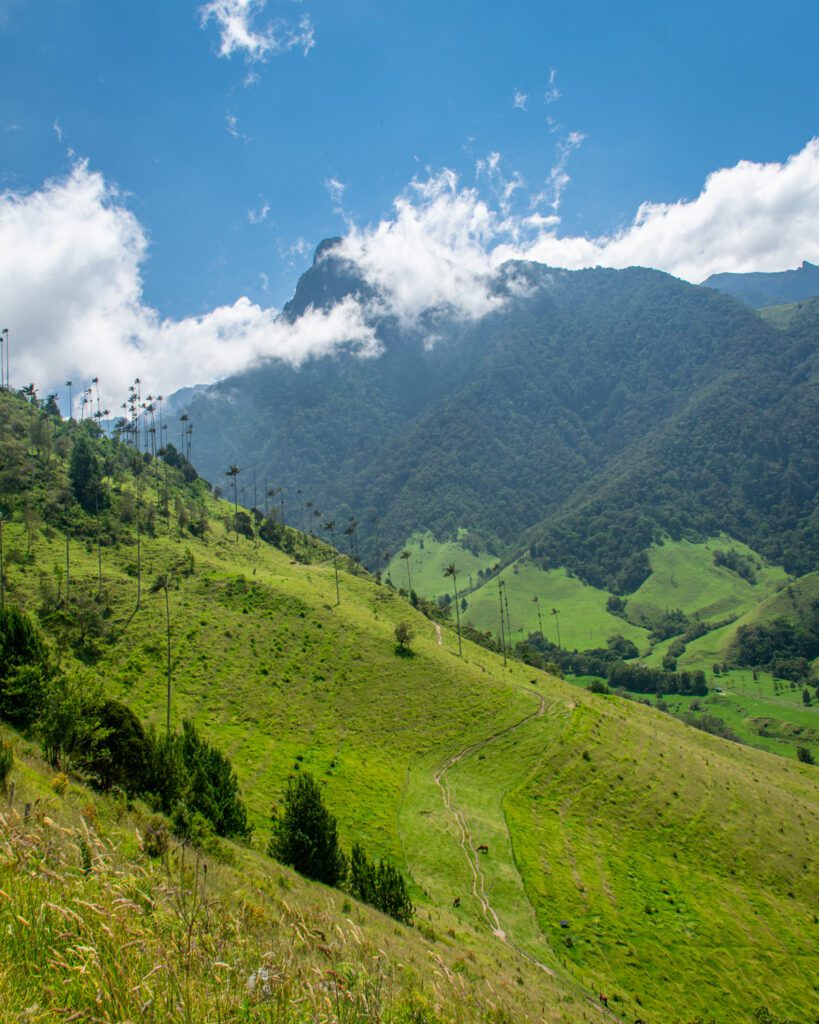
Disclaimer: Some of the links in this post, like hotel links, are affiliate links, meaning at no additional cost to you, we make a little bit of money if you click through and book. That being said, we would never recommend something to you that we don’t stand behind 100%.
Important Tips for Visiting Colombia
Our most important tip for your itinerary is this: If you only have two weeks, you’ll want to fly between destinations to save time.
Buses, while useful for extended backpacking trips, take a long time to get from Colombia’s major cities. Mostly because it’s a HUGE country, but also because it’s a country full of mountains and long, windy roads.
Rather than spending a couple of your days on a bus, opt to fly. We recommend Avianca, which is what we used on some of the longer journeys, and found it to be a great experience all around, and surprisingly affordable.
Watch out for Colombia’s budget airline – Viva Air – which is cheaper, but far less reliable. The line at the airport to check in was several miles long, I think.
Here are a bunch of semi-random things I wrote down while we were in Colombia that were notable, at least to us.
You need to be able to speak Spanish, at least a little bit. If you don’t, make sure to have Spanish downloaded on Google Translate – here’s a guide to downloading languages to use offline.
Laundry in hostels was surprisingly hard to find.
Buses work relatively well for getting from city to city, but expect to leave when the bus is full (rather than “on time”) and take 50% more time on the road because of seemingly endless construction projects along every main road in Colombia.
If you are taking long bus journeys, buy bus tickets in advance for popular legs – like Salento to Medellín. The night before or earlier in the day of your journey would be perfect. We saw people in multiple places who had to wait several hours for the next bus because they arrived right at the time of departure and the bus was already full. That being said, we also saw people get on as the bus was leaving the station, so it’s a little bit of a crapshoot. But with only two weeks in Colombia, the last thing you want is to be stuck waiting around a bus station for four hours instead of spending that time exploring. So better safe than sorry in this case.
Before your trip, download an offline Google Map of all the places you’re visiting so that you can get directions and look things up without WiFi or data usage.
Don’t flush TP down the toilet in Colombia – it goes in the waste bin next to it.
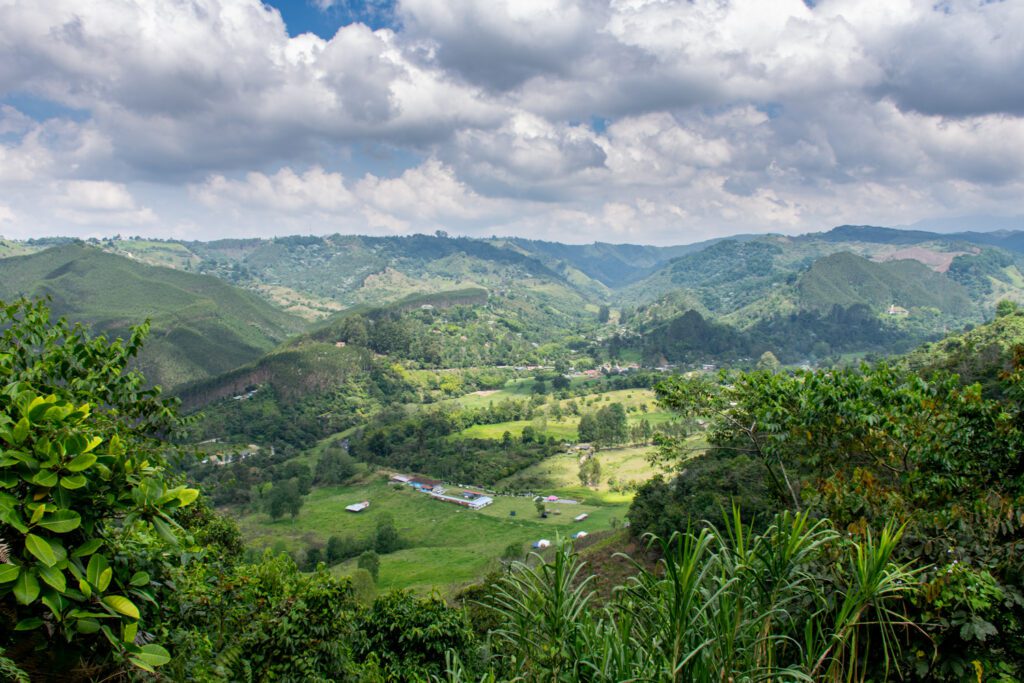
How Many Days Should You Spend in Colombia?
Look, Colombia is a huge, diverse country.
In six weeks, there were still many, many times where we said “I guess we’ll have to come back for that.” Granted, we certainly could have moved faster, but still.
With two weeks, you’ve got a solid chunk of time to see the main cities of Colombia – Bogotá, Medellín, and Cartagena – with a chance to see one or two smaller towns.
What you won’t have is a ton of time to get off the beaten path.
If you have three weeks, you’ll have a bit more time to get off the beaten path and explore some of our favorite spots that are harder to get to, like Jardín (miss you, Jardín!).
The Lost City Trek
A TON of people come to Colombia to do the multi day trek to Ciudad Perdida – “the Lost City.” We didn’t, although we kind of wish we had. It’s up north near the Caribbean Coast deep in the Sierra Nevada Mountains, accessed through Santa Marta.
The reason I bring this up is that it takes AT LEAST five days to get out there and back. Which means a huge chunk of your time is going to be eaten up.
If you do want to do the trek, know that the trade off is going to be spending less time in other places in Colombia. You will only have time to do two other cities – probably Cartagena and Medellín – and you’ll probably have to skip Bogotá and Salento completely.
Salento takes a full day to get there and back, so you’re definitely going to need to skip the rolling green hills and endless coffee plantations that make Salento special.
You have to do the trek to the Lost City with a guide – here is a highly rated guided tour that I’d recommend.
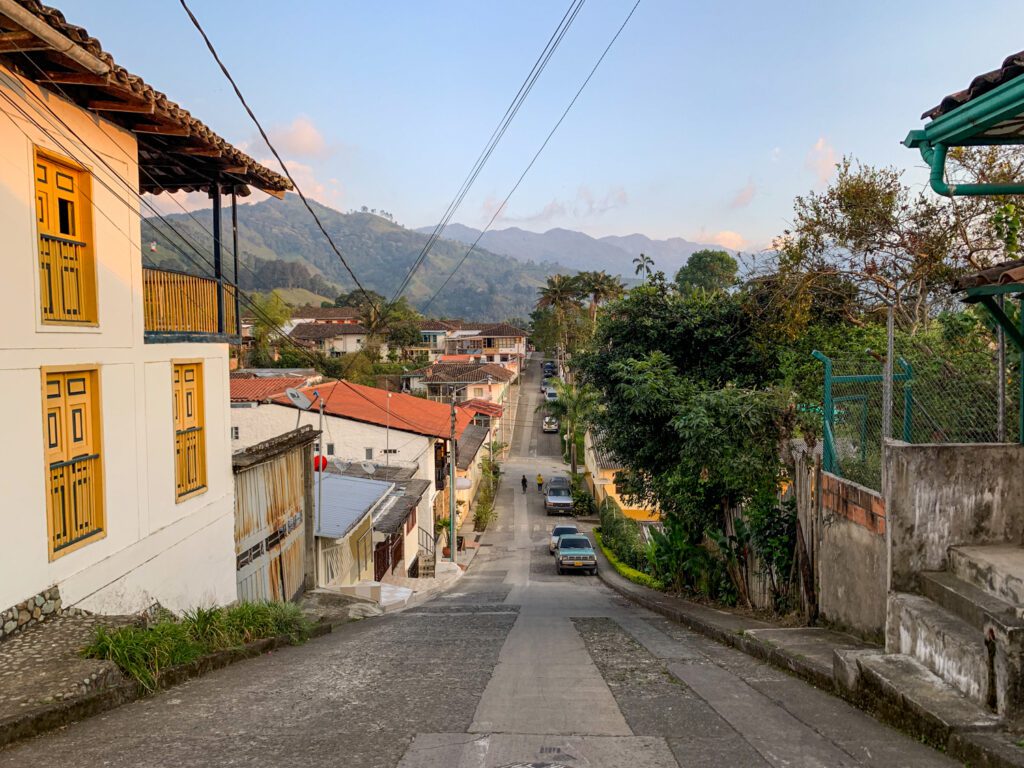
2 Weeks in Colombia: A Perfect Colombia Itinerary for First Timers
With all that out of the way, let’s get into our specific recommendations for your itinerary.
Here’s an overview of the ground you’ll cover:
- Day 1: Fly into Bogotá
- Day 2: Bogotá
- Day 3: Travel Day! Bogotá to Salento
- Day 4: Salento
- Day 5: Salento
- Day 6: Salento
- Day 7: Travel Day! Salento to Medellín
- Day 8: Medellín
- Day 9: Medellín
- Day 10: Medellín
- Day 11: Fly from Medellín to Cartagena
- Day 12: Cartagena
- Day 13: Cartagena
- Day 14: Cartagena and Fly Home
You’ll note that there are a couple of travel days carved out. Like I recommended above, I think you should fly the long routes to save time. Sure, you could spend precious time during your two weeks in Colombia on a bus. Or you could spend some extra money, fly, and spend that time exploring!
Bogotá – Days 1 & 2
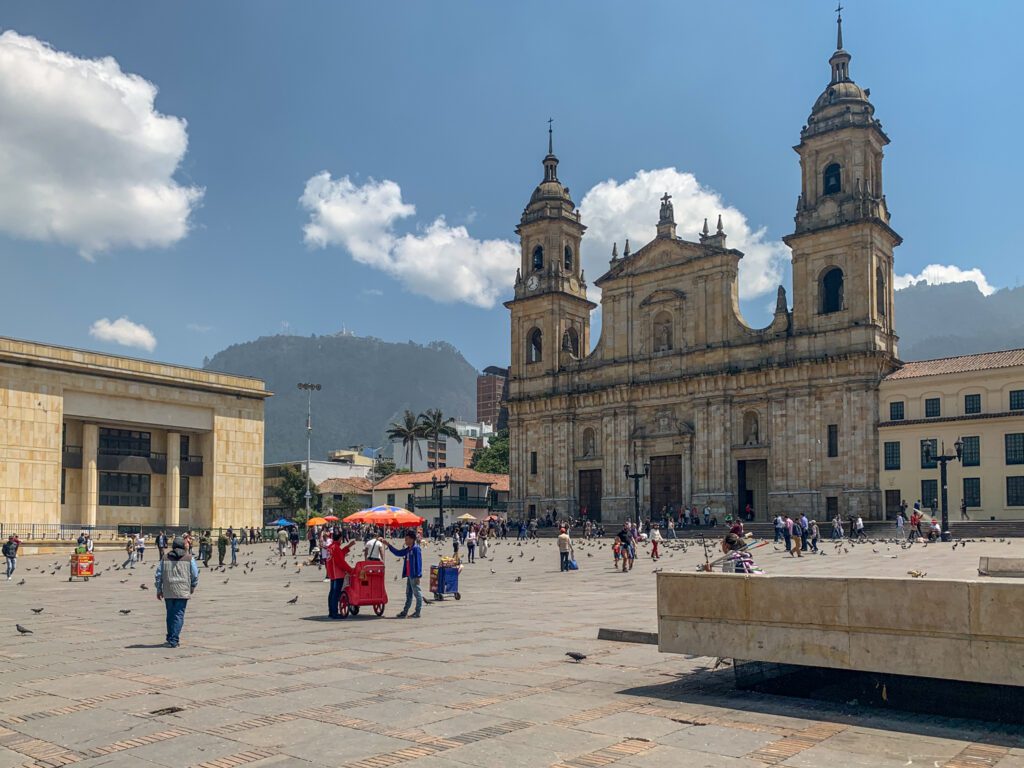
Bogotá is… a big city, with almost 11 million people. It’s the capital of Colombia, which makes it the perfect place to start your trip to Colombia, but it’s not the most interesting or vibrant city we’ve ever been to.
Still, being such a gigantic city means that there are plenty of hidden gems and exciting things to do and see, and it will serve as a perfect introduction to Colombia for your trip.
I would say that Bogotá exceeded our expectations, although that was largely because people who had visited told us that it was boring. But, to us, a city full of locals going about their daily lives is fairly interesting, and a nice contrast from the carefully curated streets of Cartagena or the tourist-laden streets of El Poblado in Medellín.
The first thing you’ll notice about Bogotá is probably “WHOA THE MOUNTAINS ARE RIGHT THERE.” True, Bogotá is in the middle of the Andes, and is at a whopping 8,700 feet above sea level! So take it easy on your first few days, drink lots of water, and give your body time to adjust.
Update 2021: We have a whole guide on planning a perfect Bogotá itinerary! It has all the details you need to plan a perfect trip to Bogotá.
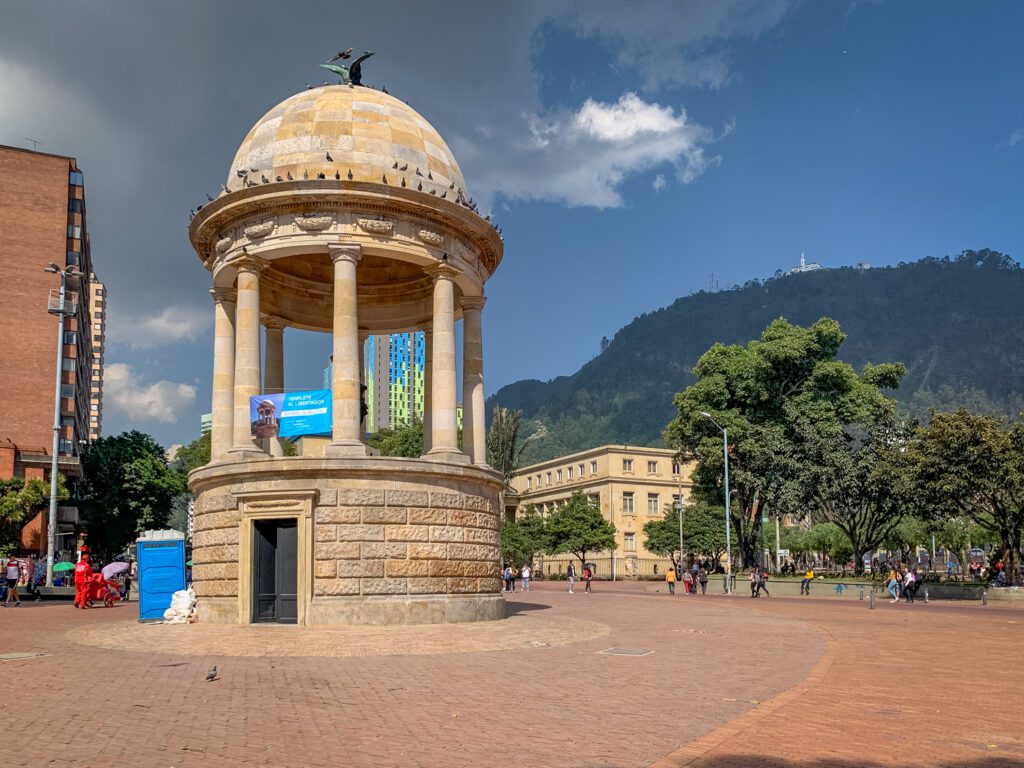
The second thing you’ll notice is probably the traffic.
We landed in Bogotá on what was essentially a “spare the air” day, where the streets were closed to all passenger vehicles, and only taxis and buses were out on the road.
We were like “whoa where are all the people” until the next morning, when it took an hour to go downtown from our place in Chapinero. It’ll take you time to cross the city, so make sure to plan clusters of things to do so you don’t have to make the trek back on a different day.
I’m assuming you’ll land early on your first day, and will spend the second day actually out and about in Bogotá.
Here is a great resource about safety in Bogotá. Among other things, never ever flag down a taxi at night. Use ridesharing apps like Uber and Beat.
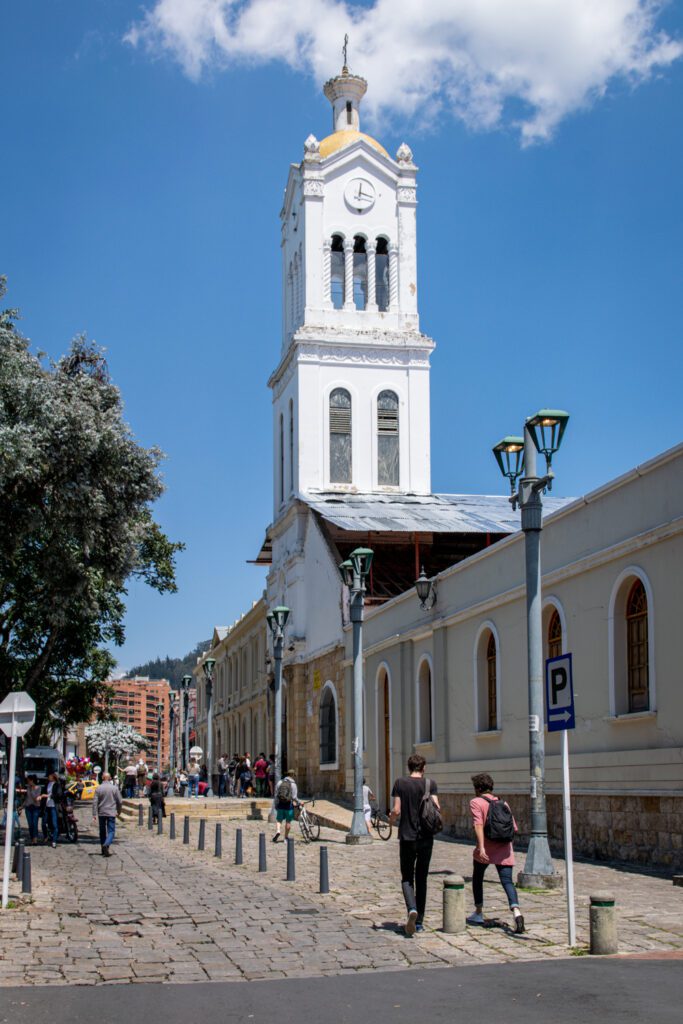
Arrival in Bogotá
You’ll land at El Dorado International Airport, the third busiest airport in Latin America. The airport is barely in the city of Bogotá, which sprawls out endlessly (as you’ll see from the top of Monserrate, if you make it up there).
Take a cab into the city to your accommodations. Believe me. The metro from the airport to Chapinero, which is the best area to stay in Bogotá, is confusing, and the last thing you want to deal with.
To get a taxi, head to the kiosk inside the airport, where you’ll prepay, then head out to the stand. Make sure to have your accommodation’s address pulled up to show the kiosk and the driver.
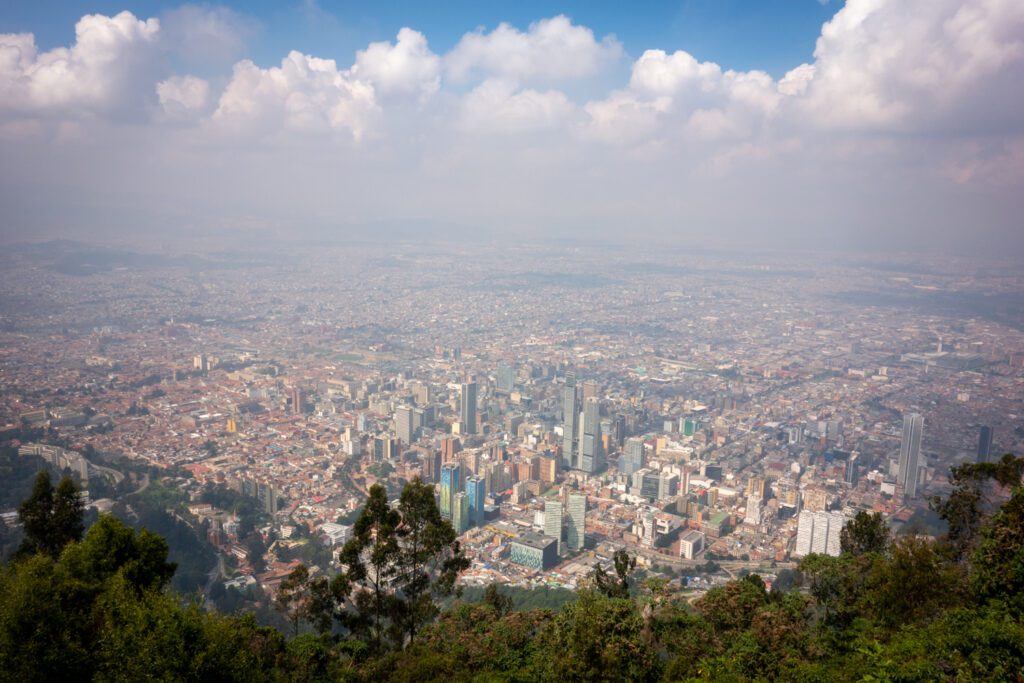
Where to Stay in Bogotá
The best place to stay in Bogotá is, without a doubt in our mind, Chapinero. Specifically, if you can swing it, Quinto Camacho, which is an area packed with restaurants, bars, coffee shops, and more.
We stayed four nights at Aurora Hostel, which is one of the “boutique hostels” in Colombia that we fell in love with, mixing the amenities of a boutique hotel (like private rooms and luggage storage) with the social aspects of a hostel, like breakfast included. Highly, highly recommend!
Update 2022: Sadly, it looks like Aurora may have closed over the course of the past two years. If you want a hostel, consider República Hostel, which is nearby. If you’re looking for a beautiful boutique hotel, check out Casa Legado.
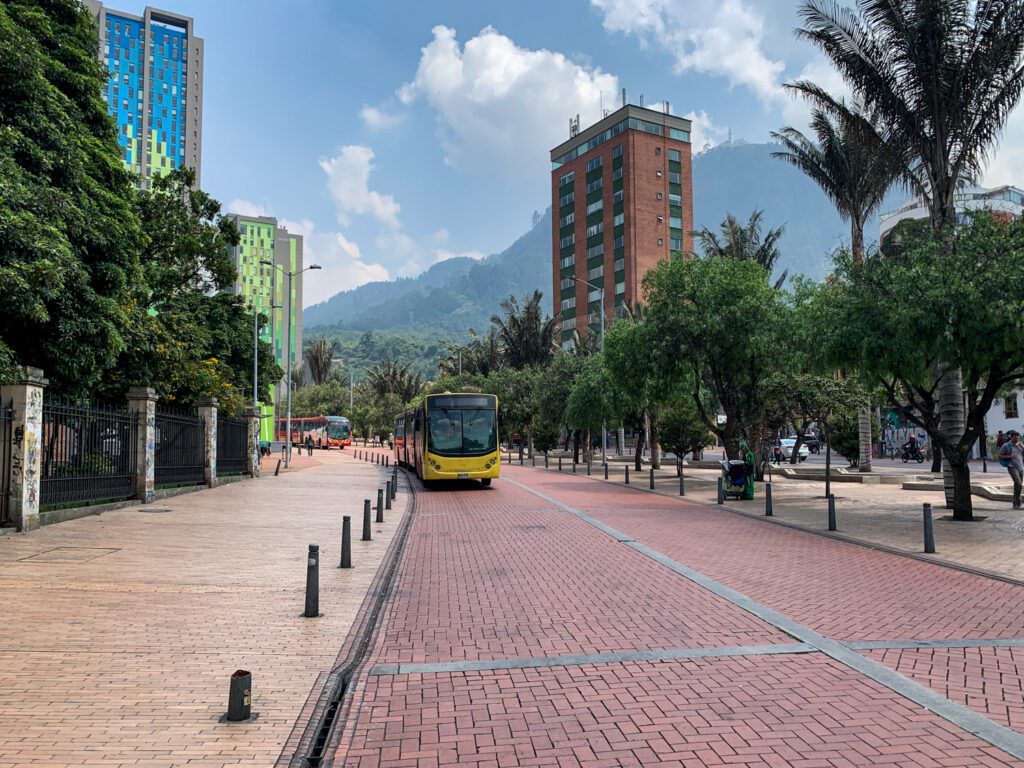
What to Do and See in Bogotá
You’ll only have a day and a half, roughly, so there’s definitely a limit on how much ground you’ll be able to cover in Bogotá. Here are some suggestions for how to spend that time recovering from your jetlag.
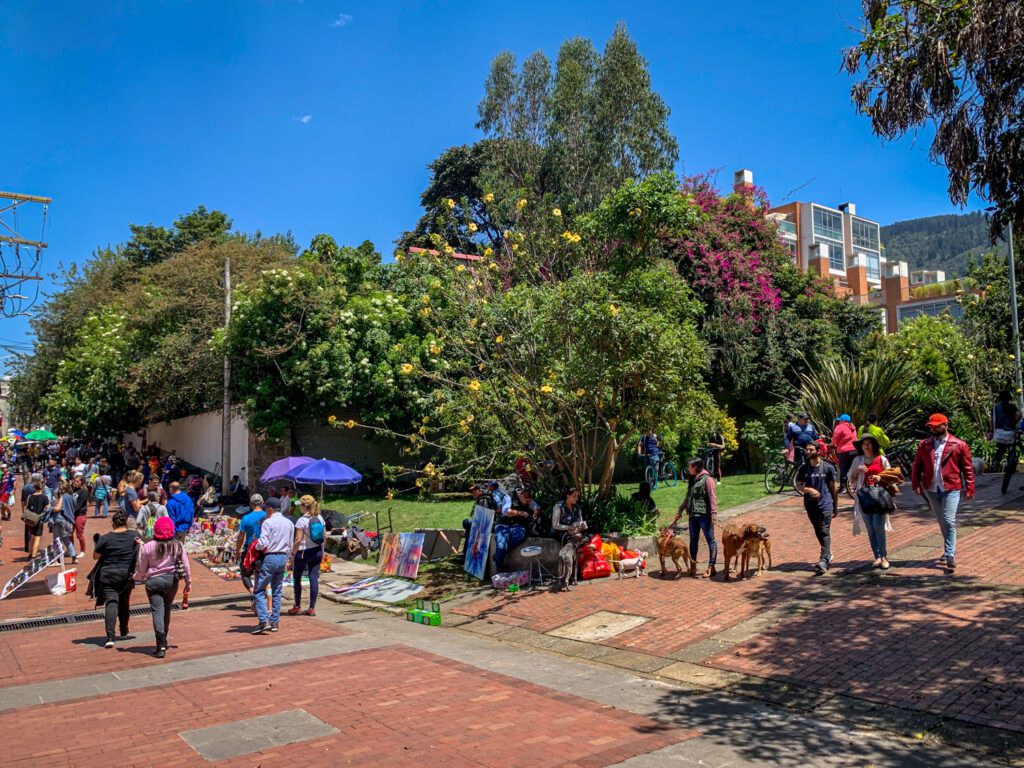
Climb Monserrate: What’s the best way to reset to a new timezone? Exercise! And the hike up to the top of Monserrate, which overlooks the city of Bogotá, definitely fits the bill. You could pay to take the cable car up to the top, which will cost you $20,000 COP (~$7 USD), though it’s cheaper on Sundays. And also WAY busier. The views from the top are nothing short of spectacular though, and are worth the climb. Past the church, there are some food vendors too, where you can enjoy a snack with a view.
Take a Walking Tour with Beyond Colombia: Our tour with Beyond Colombia was one of the highlights of our time in Colombia. We did the War and Peace tour, which was a look at Colombia’s sometimes turbulent history and served as a perfect baseline of history for the rest of our time in Colombia. It’s a free walking tour, but remember that “free” means you need to tip the guide.
Cover More Ground on a Bike Tour: On this tour, you’ll cover more ground than on foot, including tasting coffee and fruit. But the trade off is that you’ll get less of a deep dive into the history of Colombia, which is something we valued.
Taste ALL OF THE FRUITS: This tour of Paloquemao Market is something we still talk about whenever we happen to be eating fruit. Seriously, it’s incredible. You’ll go with a guide, who knows what to try, how to eat it, and who has gotten to know the vendors at the market and has relationships with the people they buy from. We went with Sylvia, a college student, and she was awesome.
The Sunday Flea Market in Usaquen: Part of the reason you should stay in Chapinero is that it’s roughly halfway between the downtown area and Usaquen, which was our favorite part of the city. And the flea market on Sundays is not to be missed. The cobblestone streets of Usaquen, which used to be a separate city but has since been swallowed up as Bogotá expanded, are filled with stands selling everything from homemade jewelry to hot sauce, and just about everything in between. It’s a fun experience, and you shouldn’t miss coffee at Colo Coffee’s garden while you’re in the area.
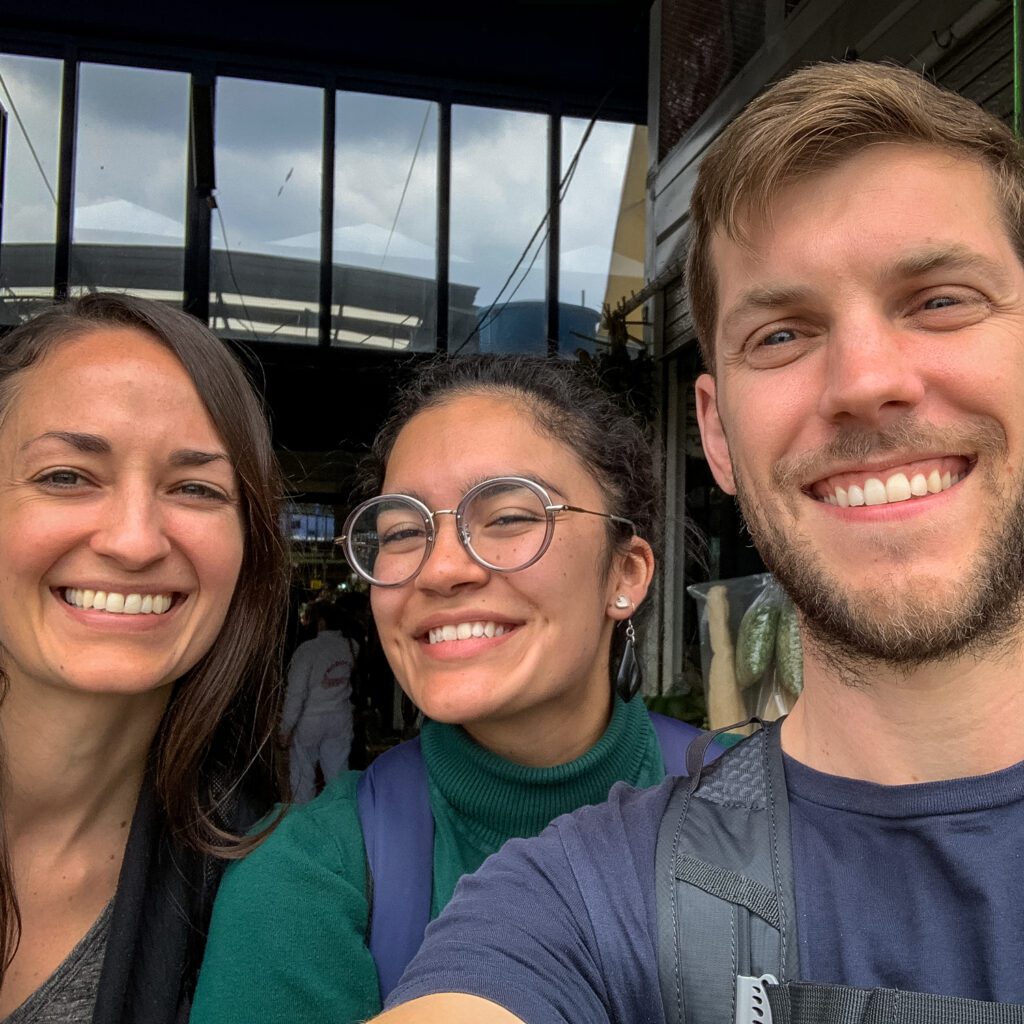
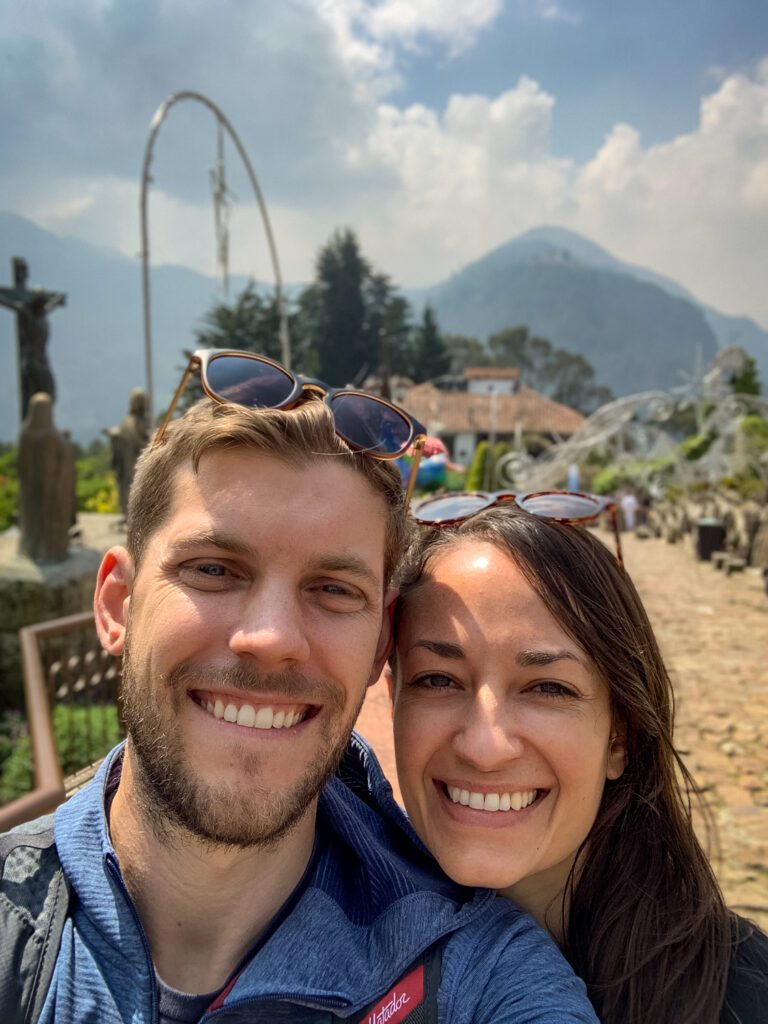
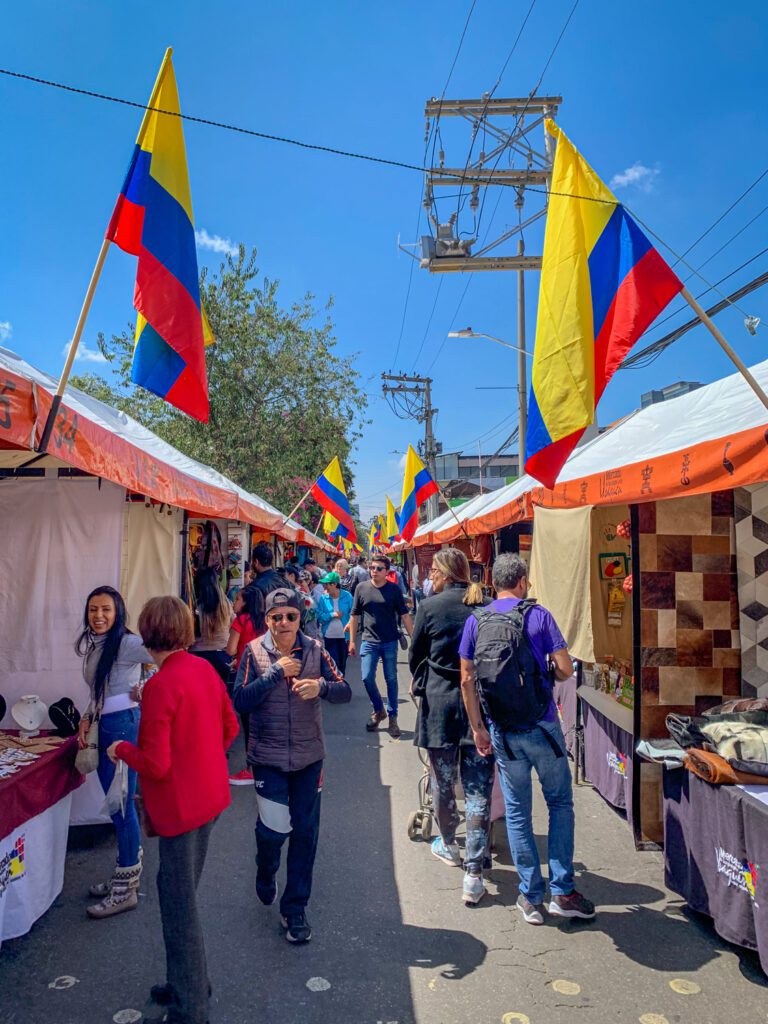
Where to Eat & Drink in Bogotá
Quinua y Amaranto – they serve one set menu every day, and it’s vegetarian, affordable, and delicious. It’s in La Candelaria, and makes a perfect lunch on the day you head down there to do the walking tour / Museo de Oro.
Abasto: Amazing brunch/lunch spot recommended to us by a local we know in Bogotá with locations in both Chapinero and Usaquen. Get the plantain leaf wrapped fish and the agua de Abasto.
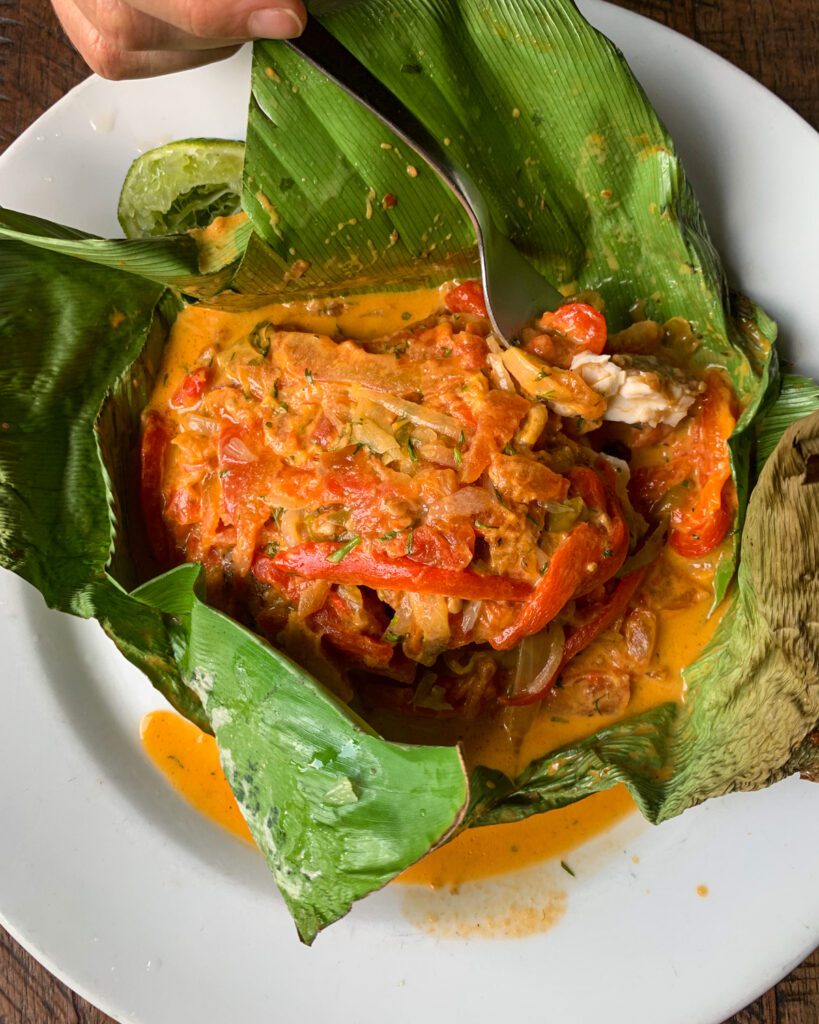
Insurgentes Taco Bar: I mean, you know we love tacos and mezcal after our multiple long trips to Mexico City.
Orso Heladería: Leave it to Alysha to find the ice cream. This spot was in Chapinero near our hostel, which means you know we had to stop by. They’re also in Usaquen and Parque 93, if you find yourself nearby.
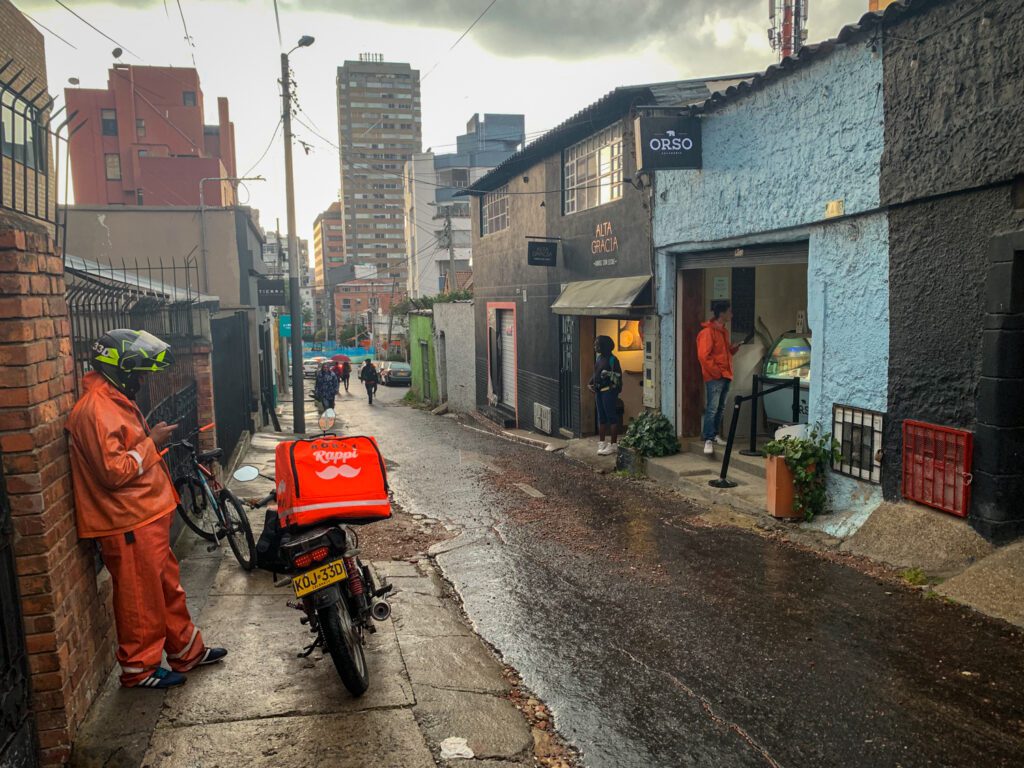
Where to Find the Best Coffee in Bogotá
Bogotá has an incredible coffee scene.
We went all over in search of Bogotá’s best coffee – here’s what we found.
Colo Coffee: This spot blew me away, specifically their Usaquen location, where they’ve built an outdoor patio area that feels like a jungle. It’s an exceedingly pleasant place to hang out. The coffee is also amazing, with a cupping lab onsite!
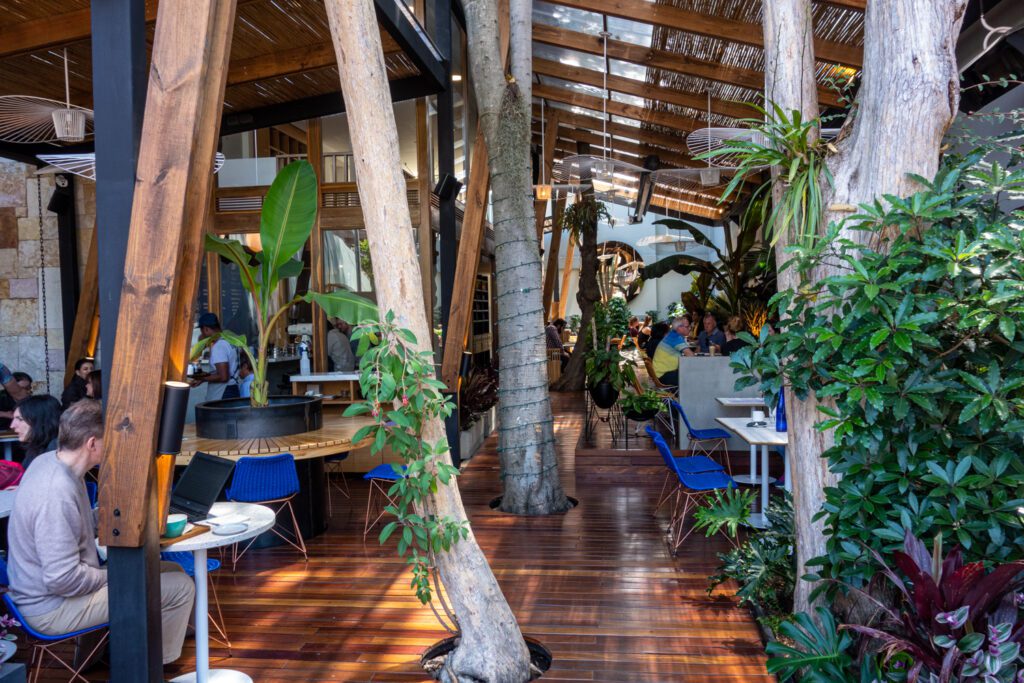
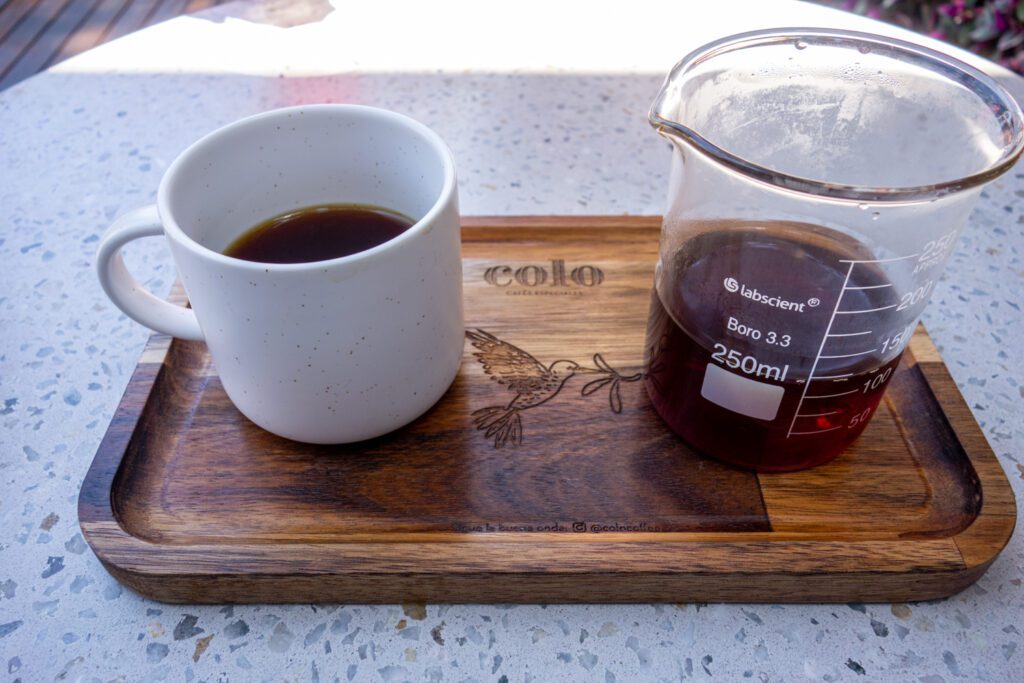
Azahar: The OG of specialty coffee in Bogotá, if not all of Colombia. It’s well worth stopping by their cafe near Parque 93or in La Candelaria to check out the people who first said “wait a minute, why don’t we get to try any of this amazing coffee that comes from our country?”
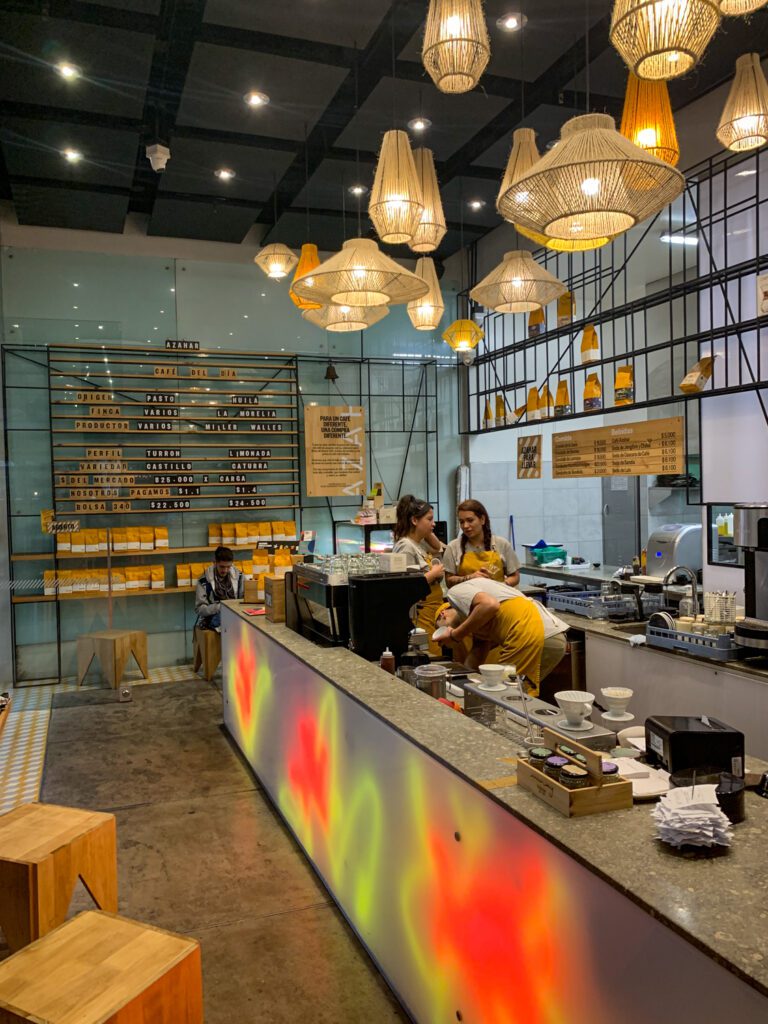
Café Cultor: We met one of Alysha’s friends at Cafe Cultor in Bogotá, and I was pleasantly surprised by just about everything about the experience. The coffee was great, the space was filled with natural light, and the location – roughly three blocks from our hostel in Chapinero- couldn’t have been better.
Days 3-6: Salento
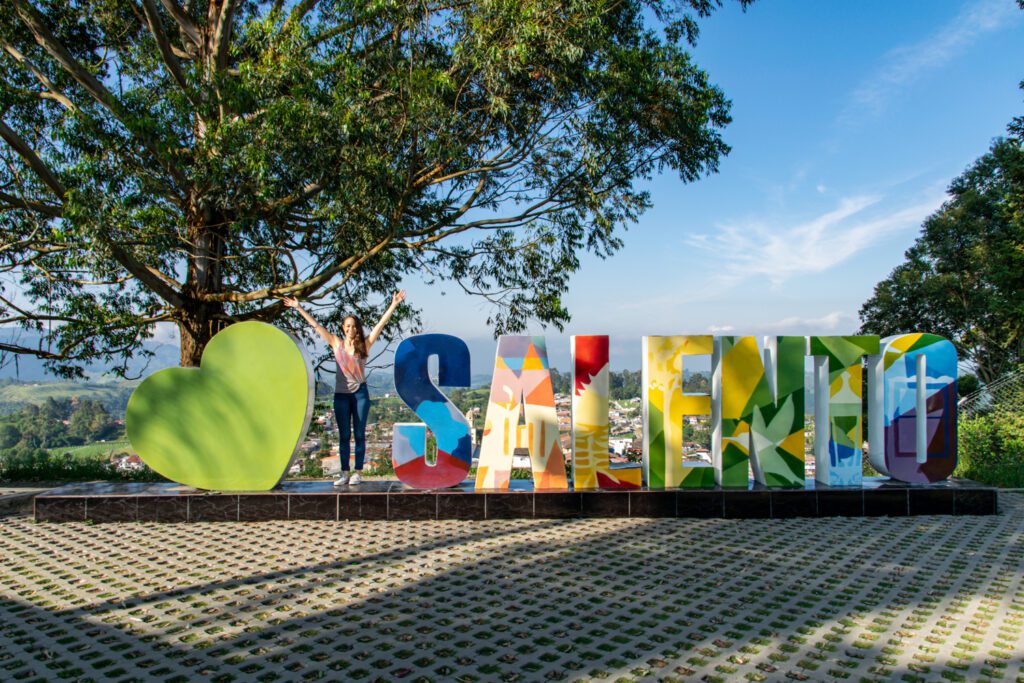
We LOVED Salento. It has everything we look for – amazing outdoor activities, including the incredible hike in the Cocora Valley, and great coffee. *checks list* yep that’s about all that’s on our “everything we love” list.
We spent a full seven days in Salento, and while it was about three days too long for most people, we were happy almost every second of it. It’s well worth a stop on your trip because it gives you a different side of Colombia than you’ll be experiencing in the other cities on your itinerary. It’s much slower, low key, and tranquilo than, say, Bogotá.
Plus, you get to ride in a Willy! Which is essentially, at least from what I understand, a Jeep with open air bench seating in the back, and is the primary mode of transportation in this part of the world. If you haven’t ridden on the back of a Willy, holding on for dear life as the driver careens around corners, have you ever really lived?
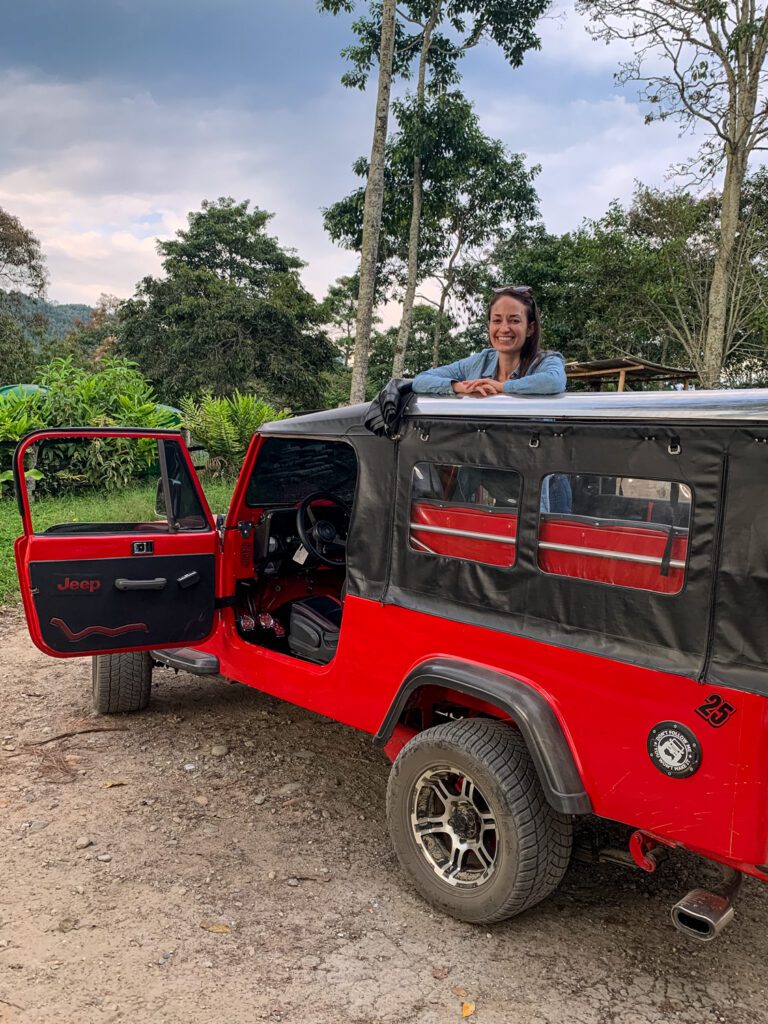
Getting to Salento
Salento is easily the most complicated city to get to in this guide. You’ll need to fly, taxi, and then bus. We flew to Pereira, caught a taxi to the bus station, then hopped on a bus to Salento from there. It took us the better part of a day.
However, after the fact I learned that it might be easier to do the same by flying into Armenia, which has more frequent buses up to Salento.
Either way, it’s going to take a bit.
Here’s a guide to getting to Salento.
As I mentioned above, definitely choose to fly Avianca over Colombia’s budget airline Viva Air.
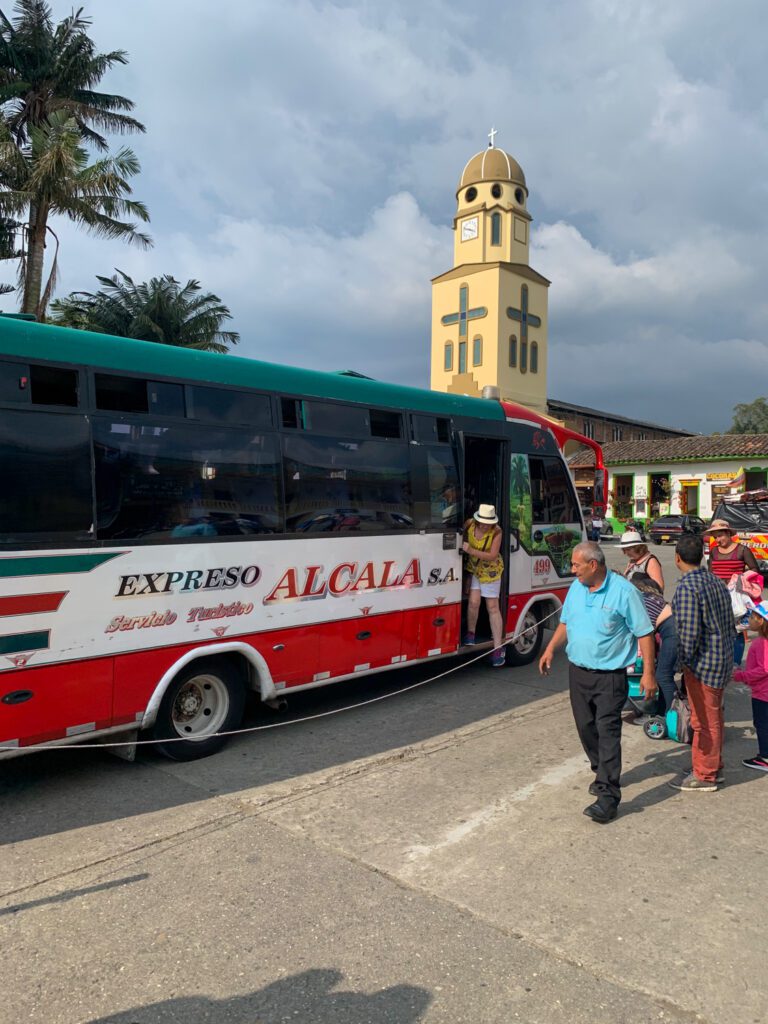
Where to Stay in Salento
We spent a full seven nights at Hostel Tralala and felt at home. They have a bunch of private room options – both with private bathrooms and without – along with a dorm and a nice kitchen. It’s a block off of the main square, and is relatively affordable. One thing that stood out to us was the staff, who were super helpful, navigating our broken Spanish to give us directions to the coffee farms, for example.
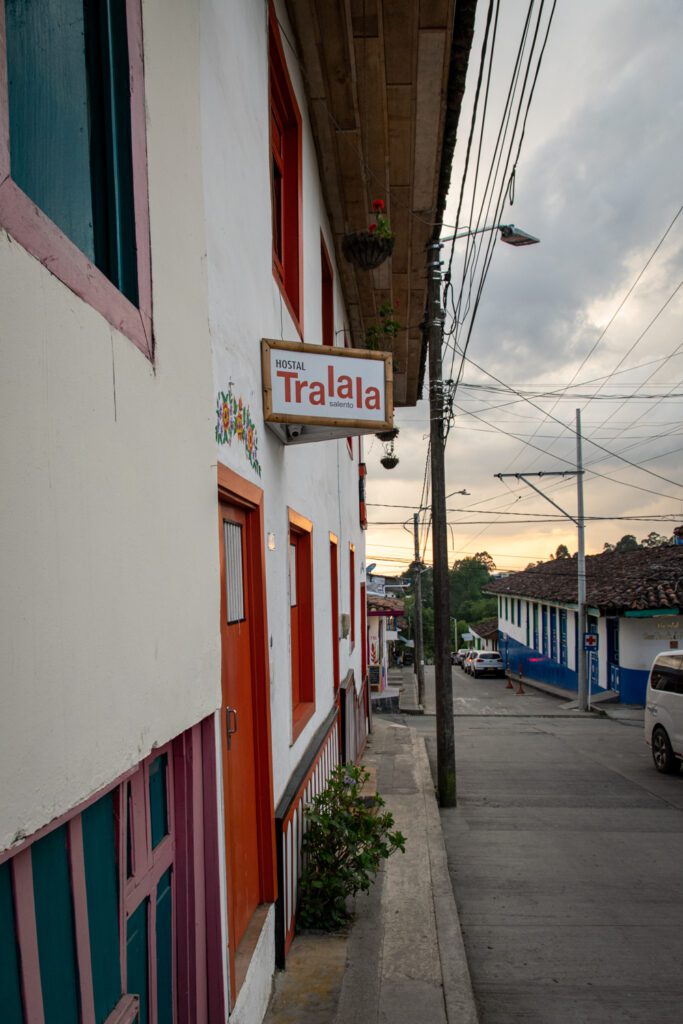
If you’re not into the idea of a hostel, there are plenty of great hotels in Salento. Here are two highly rated options that caught my eye.
Hotel Terasu looks gorgeous, with light-filled rooms with modern touches, some of which have balconies with spectacular views, and a breakfast that basically every review mentions.
Kawa Mountain Retreat would be my other pick. It’s an eco-friendly hotel with spacious rooms (again, some have balconies with hammocks and mountain views) and it’s just a short walk to the center of Salento.
What to Do and See in Salento
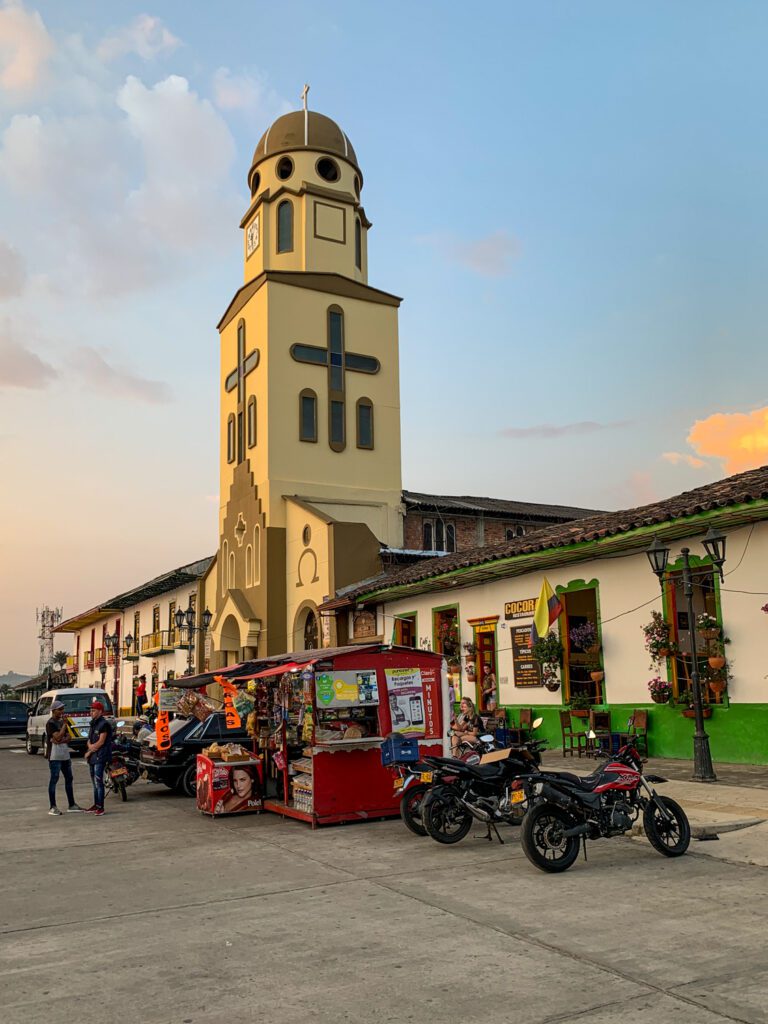
You’ll be in Salento for three days and four nights, which means you have plenty of time to check most of these things off the list.
The Cocora Valley
The Cocora Valley, which is simultaneously the reason everyone comes to Salento, and is also essentially dying due to the impact of livestock and increased foot traffic. The wax palms are unlike we’ve personally ever seen before, especially combined with the mountains in the backgrond.
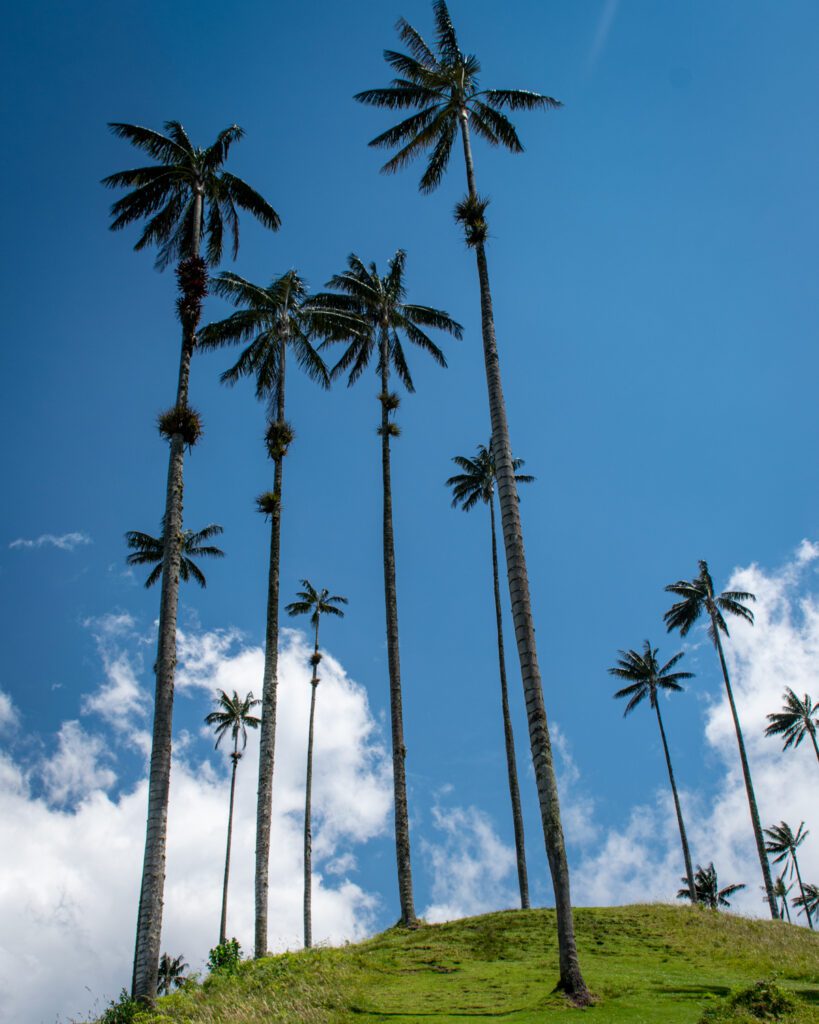
We highly recommend doing the long loop – bring plenty of water and snacks, it took us most of the morning.
Most of the people you see will head straight for the mirador, which is to the left (or really, the main road straight ahead) when you get dropped off, but you should veer to the right and walk past the little gate to start the loop. You’ll cross a bridge, and then pay $2,000 COP per person to enter.
The trail wanders through open fields past the cows responsible for the death of the wax palms (they eat the vegetation on the ground, which disrupts the entire ecosystem that supports the wax palms) and through the forest, crossing several bridges that look like they’re straight out of an Indiana Jones movie.
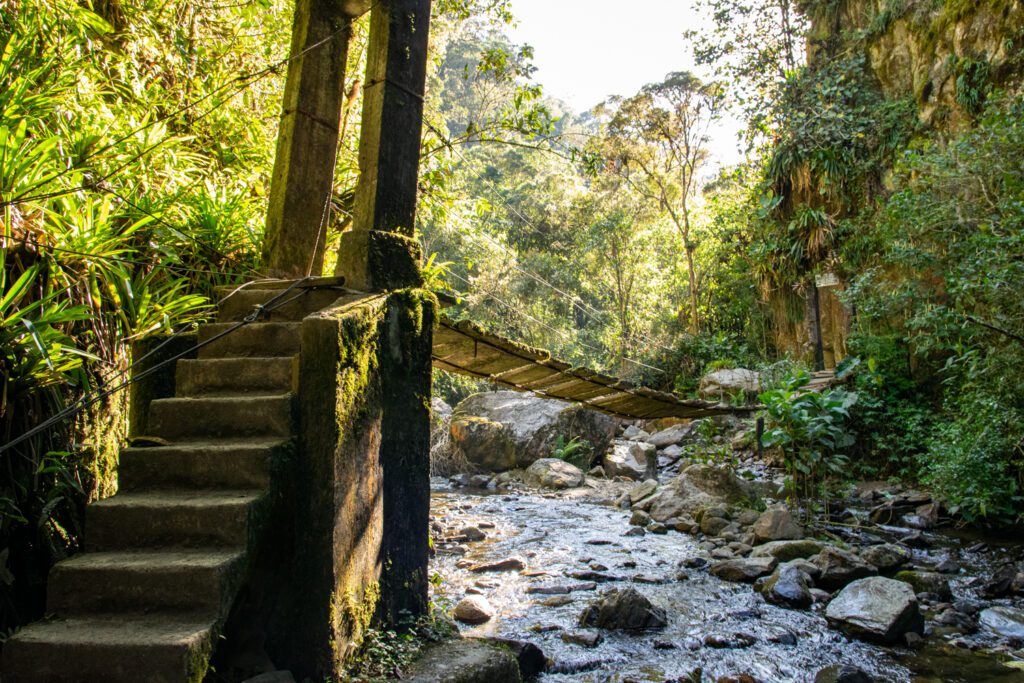
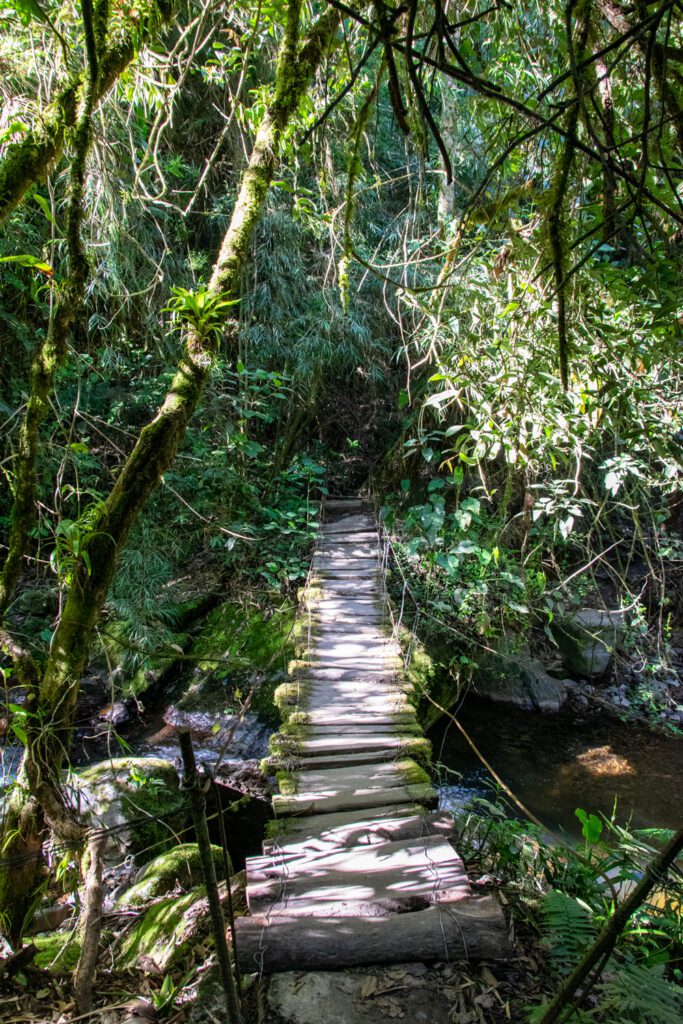
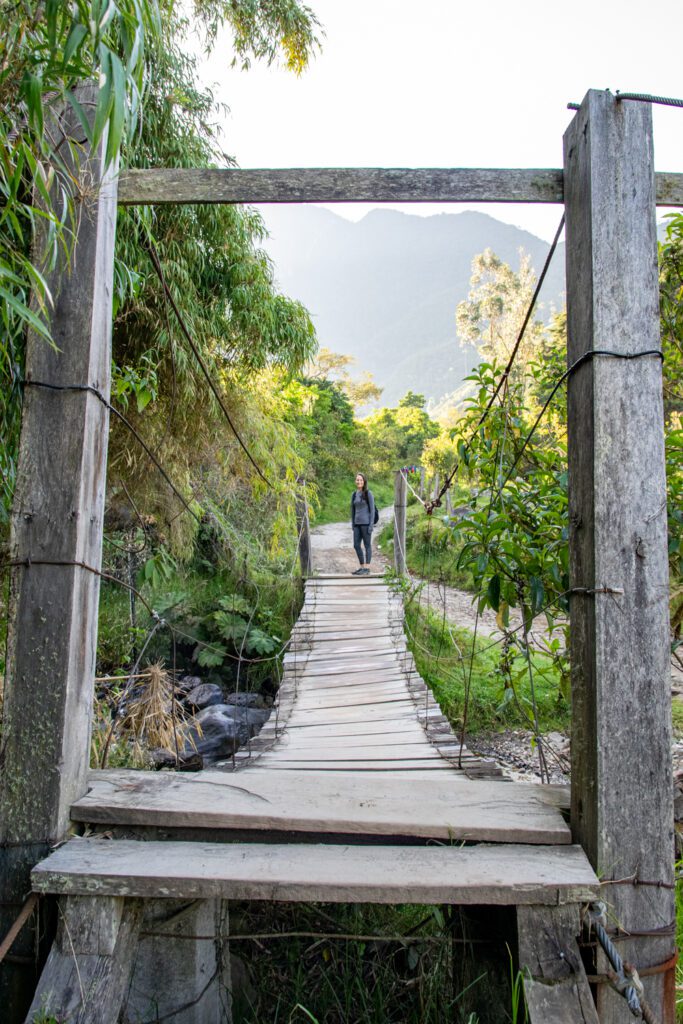
Eventually, you’ll reach an intersection – straight takes you to the hummingbird preserve, which is worth a detour but is definitely a climb, and left takes you up the steep trail to a viewpoint over the valley, where you’ll start the descent to the famous viewpoint from above.
To get to the starting point for the hike, you’ll take a Willy from the town square in Salento.
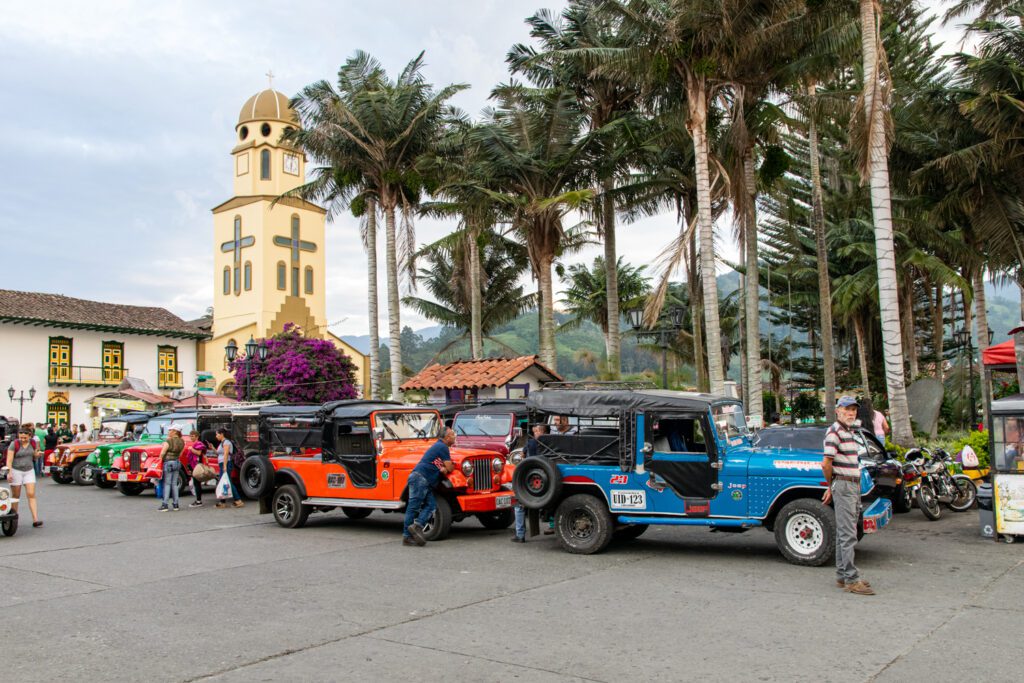
Try to get there early – they sell out, and often we heard people say that they had to wait hours before they could get out there. We caught the first round of Willys of the day and had no problems at all. There’s a stand on the northwest side of Plaza de Bolívar that sells the tickets for the Willys.
Tour a Coffee Farm
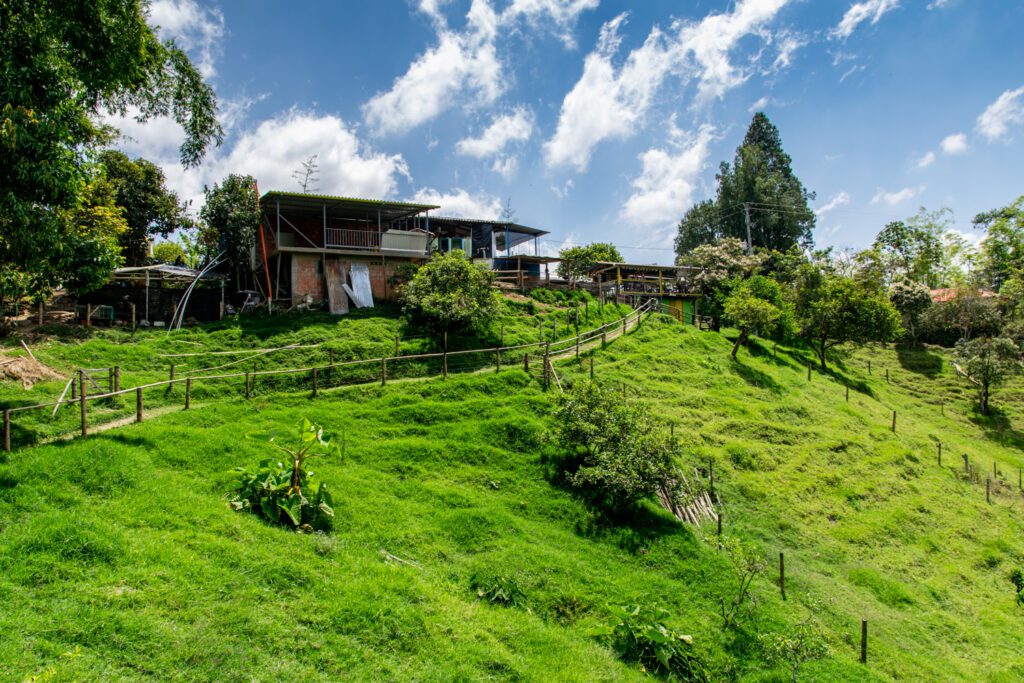
When we were planning our trip, we knew we wanted to explore Salento for two reasons. The Cocora Valley, because we’re big hikers. And coffee, because I’m a coffee snob, at least according to Alysha, who doesn’t drink coffee at all.
In Salento, you have plenty of options when it comes to coffee farms, and they make a nice half-day trip.
Walk out of town across the bridge on the west side of Salento on Carrera 5, and head southwest along Salento-Vda. Palestina, which is a dirt road that winds down into the valley to the best coffee farms in Salento – Las Acacias, which is a smaller, more intimate experience, and Finca el Ocaso, which is a much more commercialized operation.
It’s cool to see the contrast between them, and I’d recommend doing both.
Las Acacias tours leave basically when there are enough people ready to go and take about an hour, and Finca El Ocaso’s basic tour ($25,000 COP) leaves at 10am, 12pm, 2pm, and 4pm, and lasts 90 minutes. When you’re done, catch a Willy back to town at Finca El Ocaso because the walk home, which is uphill and dusty, is not super pleasant, speaking from experience.
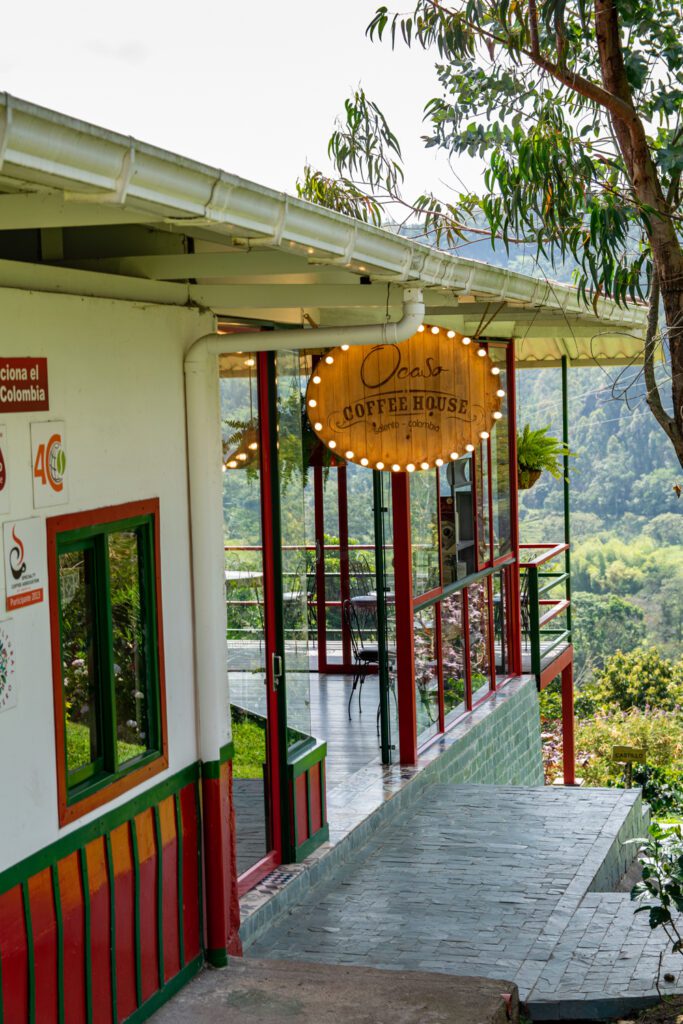
Finca el Ocaso also has a “premium” tour, which is a smaller group and includes a cupping of different coffees at the end. I did it and enjoyed it, but it’s probably best for people who are really into coffee since it costs $70,000 COP and isn’t much different from the other tour, save for the cupping.
Walk up to the Mirador
At the end of Calle Real, the main street running east/west in Salento, you’ll find a set of stairs. At the top of those stairs is a nice viewpoint with views over the small town and a very ‘grammable Salento sign.
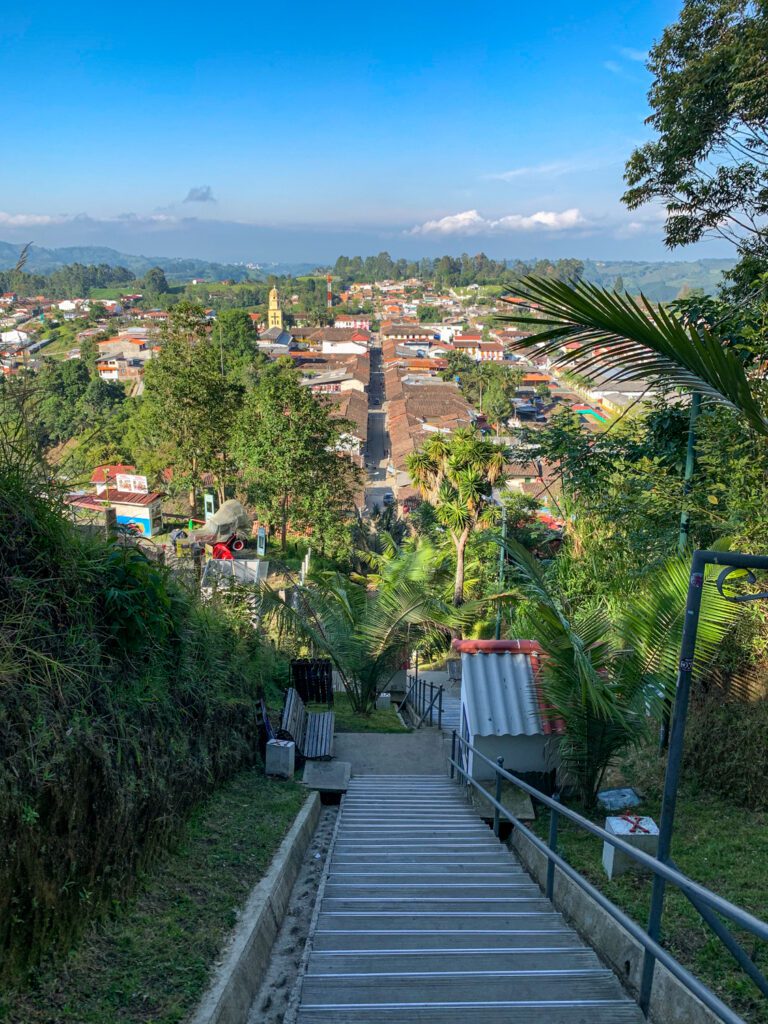
Play Tejo!
Tejo is a game where you throw a little metal disc at a target, which is filled with gunpowder and explodes if you score a direct hit. Sound dangerous? It probably is, but not as much as you’d think.
Either way, it’s something you should do at least once while you’re in Colombia, and Los Amigos in Salento is a great place to try it.
Ride a Horse to a Waterfall
Every single morning in Salento, we woke up to the sound of “clop clop clop” as men, who were always wearing a cool fedora-adjacent hat that I DEFINITELY couldn’t pull off, led their horses to the starting point for a busy day.
One way to use the horses? Ride to Santa Rita waterfall.
You can also do this on foot, but the directions we got were less than stellar and involve crossing private land and paying an entry fee. I’d hire a guide, which your hotel/hostel can help arrange.
Days 7-10: Medellín
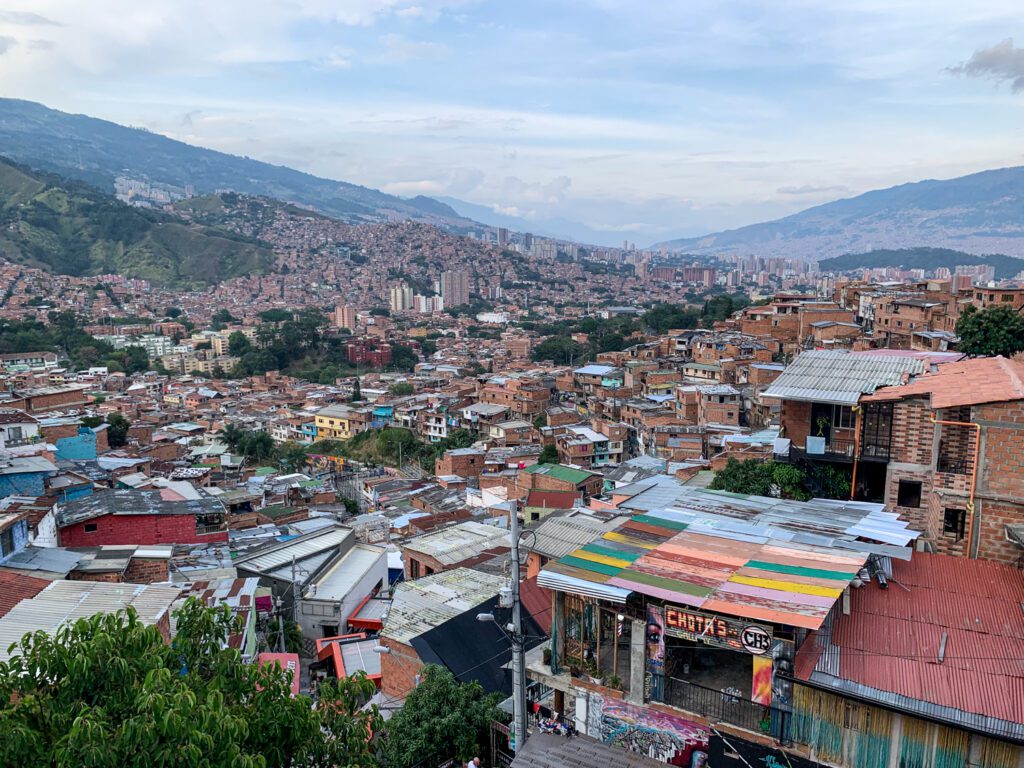
Medellín was our favorite city in Colombia, and we ended up spending a full ten days there over the course of our six week trip. It’s a beautiful location, set in a lush valley between towering mountains, and the story of the growing city is compelling.
You might know it because of Narcos and its infamous past – it was the most dangerous city in the world in the late 80’s and early 90’s – but the transformation it has gone through since is impressive.
Big investments in public infrastructure, including a metro system that puts most US public transportation systems to shame in terms of efficiency and cleanliness, have brought more opportunity to more people in Medellín, which has in turn helped to create a safer, innovative, and more vibrant city over the past two decades.
I think we, as Americans, have a lot to learn from cities like Medellín, where they consciously chose to invest in underserved communities by connecting people to opportunities with the efficient metro and super innovative cable cars (read: gondolas) and building community centers, schools, and libraries in those neighborhoods.
As we were on a walking tour learning about it, I turned to Alysha and remarked that I could not imagine a world where most Americans were cool with putting money into schools and other institutions in underserved communities, unless they lived there.
Which is pretty sad, when you really stop and think about it.
How to Get to Medellín
First of all, DO NOT TAKE UBER in Medellín. It’s illegal (at least it was when we were there), and there are police along the road to and from the airport looking for Uber drivers to pull over and ticket.
To get from Salento to Medellín, the most efficient way is going to be busing to Armenia (or Pereira, but there are more frequent buses going to Armenia from Salento) and catching a flight to Medellín. The bus will take 20-30 minutes, and the flight is under an hour.
You could take a bus between the cities, which leaves from Salento’s small bus station on the northwest end of town, but it’ll take at least 6-7 hours, if not more. The flight will cost you about $40-50 a person, but it’ll save you several hours of time that you can spend exploring rather than sitting on a bus.
There are two airports in Medellín, but the one you’ll be flying into if you took our advice and flew Avianca is José María Córdova International Airport (MDE). And it is FAR. It’s 21 miles outside the city, and it will probably take between 30 and 45 minutes to get into the city.
Once you arrive in Medellín, the best option to get to your accommodations is going to be taking a taxi. Rates for the sanctioned white taxis are set, and will cost you $80,000 COP.
You could also take a collectivo – a shared bus where passengers split the cost – which will take you to San Diego Mall in Medellín. The cost is going to be ~$19,000 COP per person. From there, you’ll need to grab a taxi for the short ride to El Poblado, which is where we recommend you base yourself in Medellín.
Once you account for the extra taxi ride you’ll need to take, the difference in price between a collectivo and a direct taxi is going to be about $10 USD, assuming you have two people (the difference is even smaller if you have more than two people).
Where to Stay in Medellín
We found ourselves in Medellín twice, and decided to stay in two different neighborhoods – El Poblado and Laureles – to get a feel for which one we preferred. Turns out, it’s not as simple as one is better than the other. There are tradeoffs. Both are plenty safe, so that’s not even a part of the equation here.
El Poblado is filled with more gringos and digital nomads than Colombians, or at least that’s how it felt at times. It has been the upscale part of the city for decades. Still, it’s super conveniently located, with a dazzling array of restaurants and bars lining the streets, and a metro stop within walking distance. While you might hate feeling like a tourist by staying here, it’s a really nice and convenient place to stay.
Laureles is a much more pleasant and relaxed place to stay, with plenty of bars, restaurants, stores, and more within walking distance. But it’s not very well connected to other parts of the city via the metro, at least in the part of the neighborhood we stayed in (Estadio was the closest metro stop).
El Poblado is a slightly more convenient location to base yourself in, and it has a much better selection of places to stay – hostels, Airbnb, and hotels. For that reason, El Poblado is our top pick, but it’s close.
We stayed in a private room at both Los Patios Hostel in El Poblado, and Casa Cliché in Laureles and would recommend both. Los Patios is a big hostel that feels almost like a hotel, with nice kitchen facilities and a rooftop bar. Casa Cliché is a much smaller operation, and has a great little patio area out back.
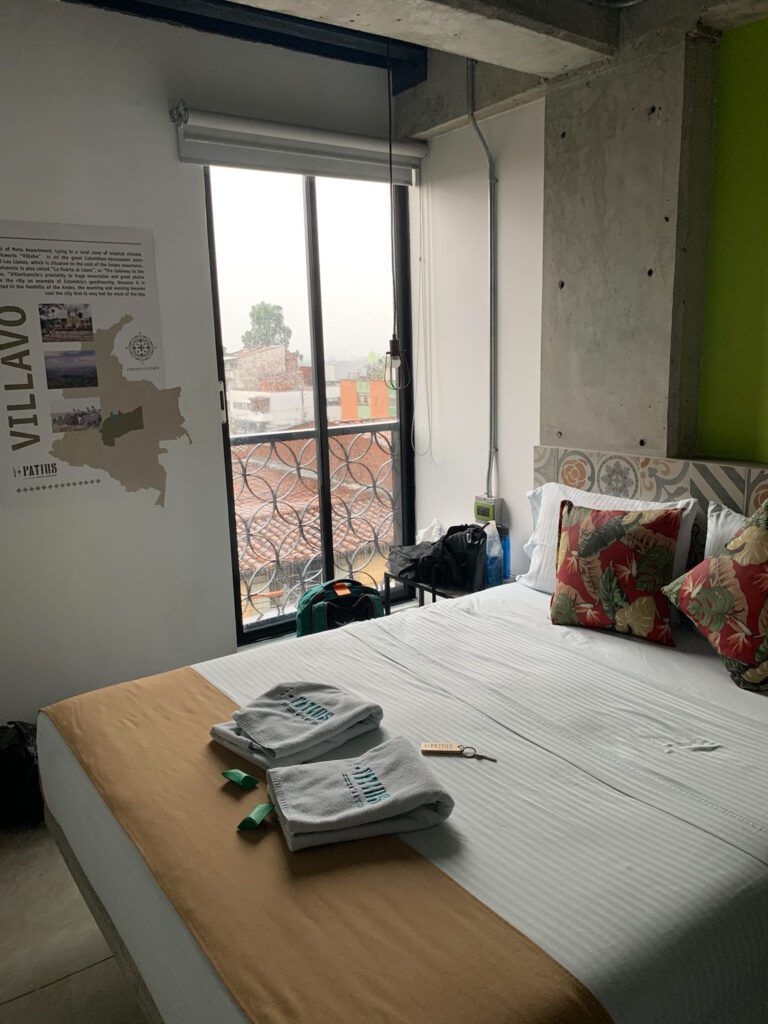
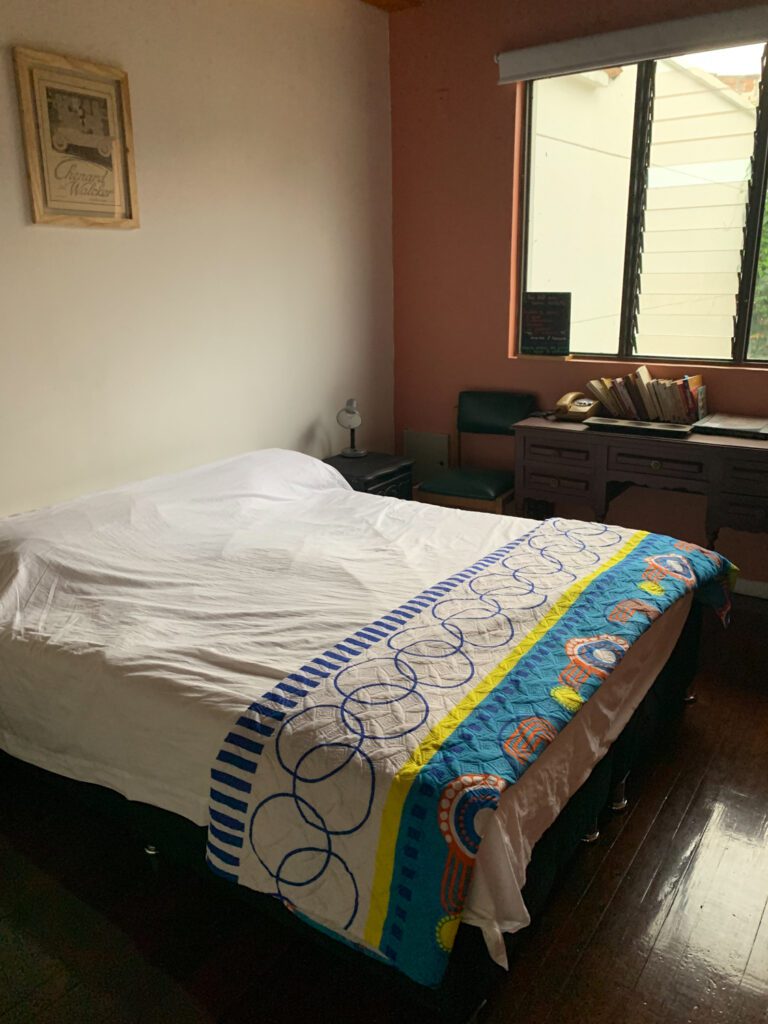
What to Do and See in Medellín
Like I said above, we loved Medellín. There’s a great variety of things to do and see, and plenty of ways to learn about the history of the city to give you solid historical context for the city you’re enjoying today.
I strongly recommend that you avoid doing a “Pablo Escobar” tour, which romanticizes the violence that plagued Medellín just a few decades ago.
Instead, do this Communa 13 tour with Sebastian, a local who weaves together a compelling story that focuses on the post-Pablo era and the innovation and investment in the community that has transformed the city. We loved it, and wholeheartedly recommend it.
From Violence to Innovation (Communa 13 Tour)
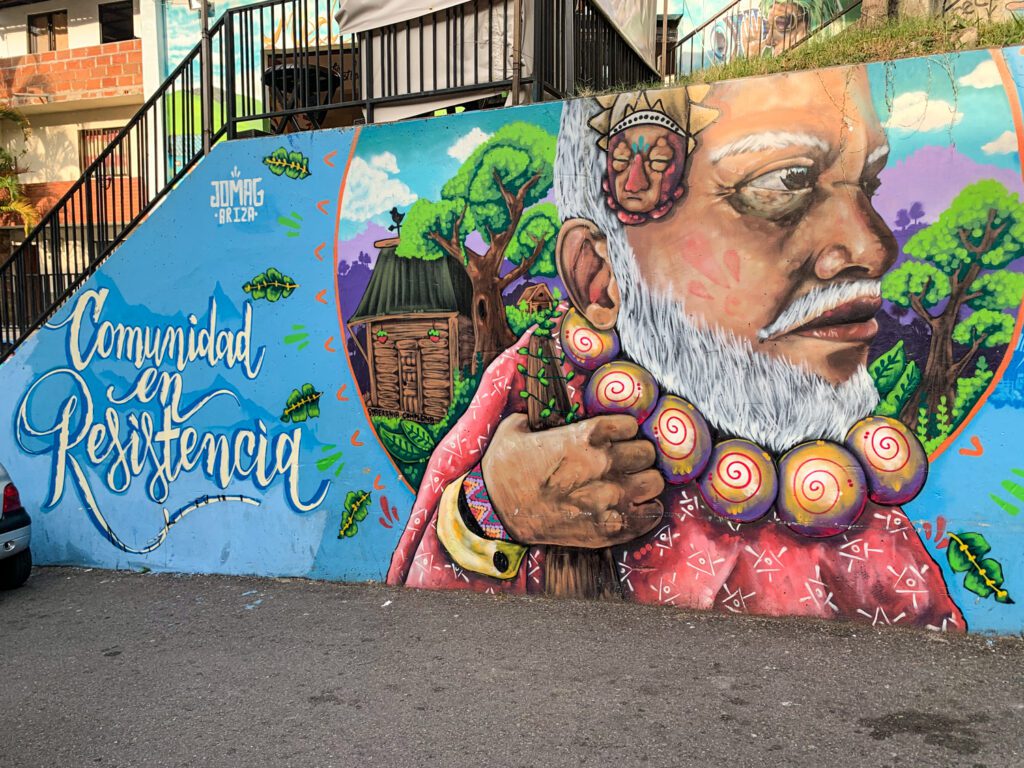
I mentioned this above – you’re going to want to see Communa 13 and its mesmerizing street art (which is truly some of the best I’ve ever seen).
I would do this tour, which we did and I referenced above, which doesn’t just take you to the graffiti and say “Look, some graffiti!” Instead, Sebastian teaches you about Medellín’s history, and how it has gone from the most dangerous cities in the world to one of the most innovative and forward-thinking over the course of the past 10-20 years.
It’ll take a full afternoon, but you’ll start downtown, walk to most of the important sights in that area, then take the metro and cable cars to get to Communa 13, learning about how it all came together along the way.
Take a Cooking Class at a Social Project
When I told my mom that I was going to Colombia, she told me that one of her friends recommended I connect with a guy that does a cooking class in Medellín whose proceeds benefit a social project he’s running. Me being me, I didn’t reach out to him.
But we booked a cooking class in Medellín (as we do), and about fifteen minutes into it as Brian, the chef and owner, was explaining his whole operation, I connected the dots.
Brian is an amazing chef who runs classes for the local community, teaching them to use the abundance of amazing food in Colombia to create healthier, globally inspired meals, among other things. He also teaches that cooking class for tourists, where you’ll learn more about Medellín and Colombian food than on all of the tours above combined.
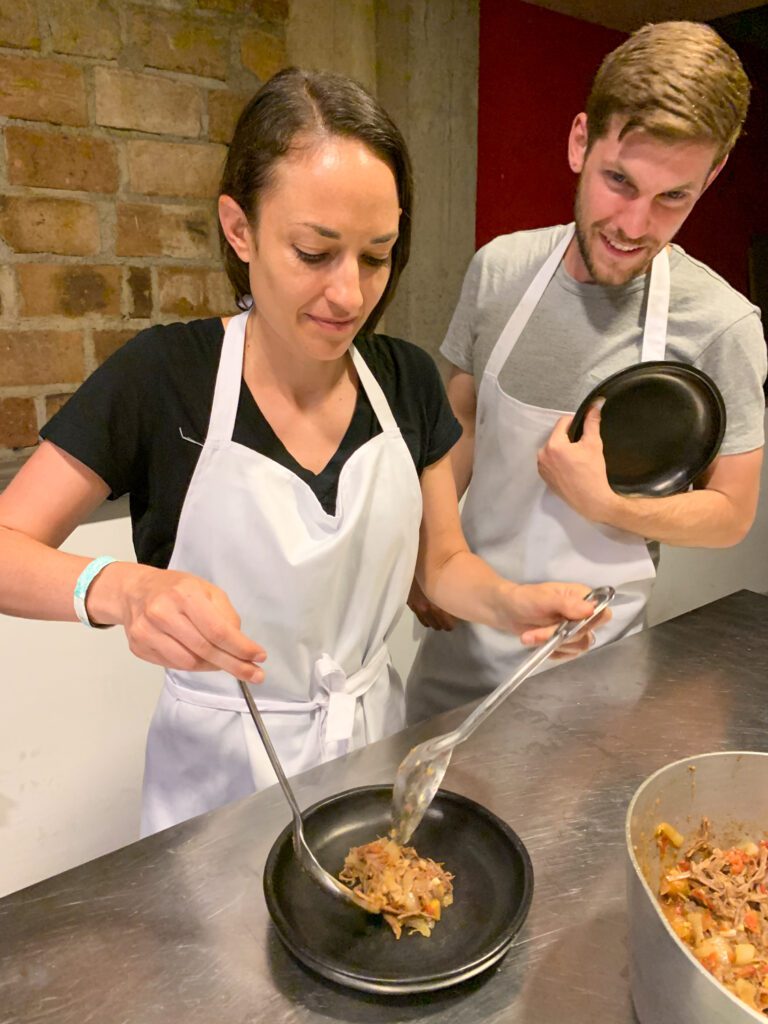
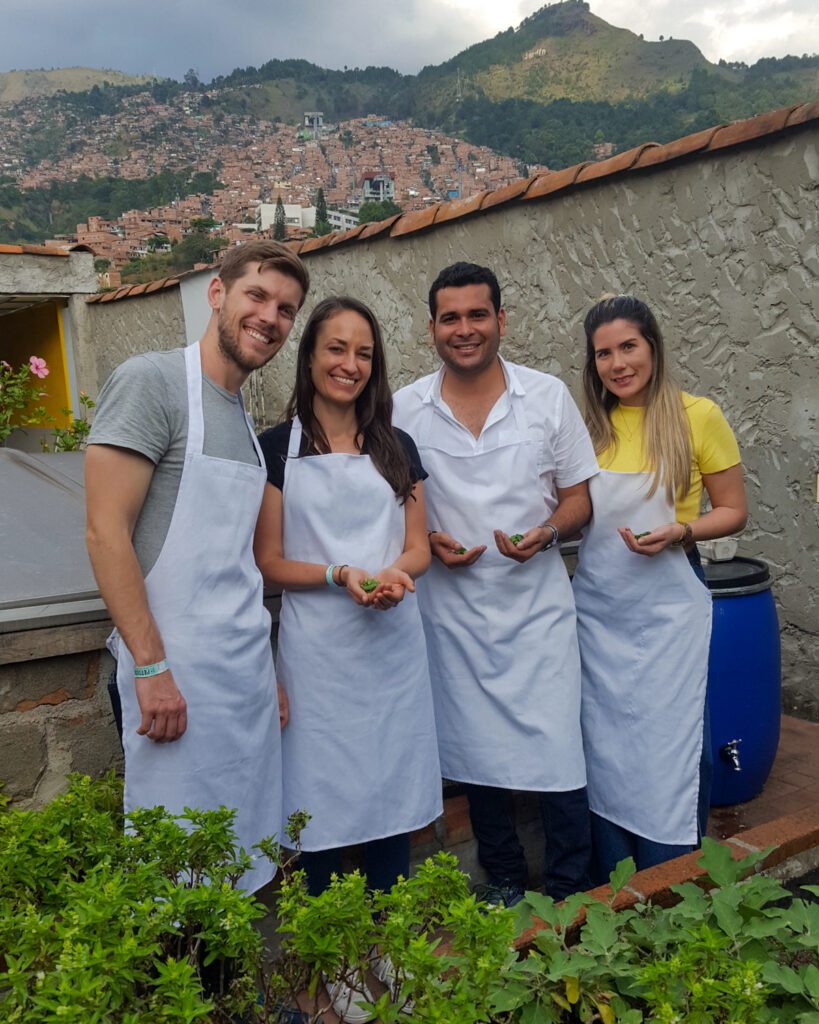
While Brian is not Colombian, he has an impressive knowledge of the issues and current events in the city.
We loved the class we did with him, and would highly recommend it both for people looking to learn how to make Colombian food, and for people who want to learn more about Medellín. We happen to fit both categories.
Catch a Soccer Game
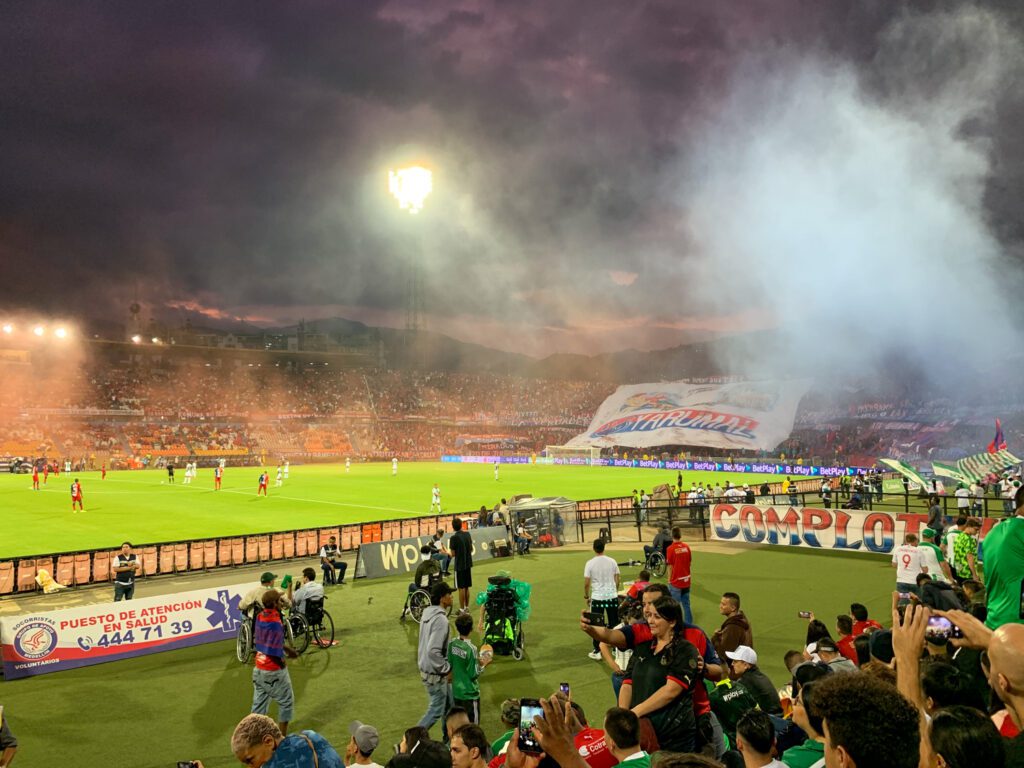
I’m a huge soccer (futbol) fan, and when I found out that there was a game when we were in town between the two Medellín clubs, I was ECSTATIC.
Seeing a soccer match in South America has been on my bucket list for years, and it did not disappoint.
We opted to go with Mateo on this Airbnb Experience, which included transportation to and from the stadium from El Poblado, a drink outside the stadium, great seats, and his encyclopedic knowledge of the club he supports – Atlético Nacional.
The atmosphere of the stadium was raucous – with drums beating throughout the entire match. You’ll even get a chance to take photos on the field at halftime if you want, which was super cool. Highly recommend for soccer/football/futbol fans – even Alysha enjoyed it.
Taste all the Fruit
If you missed the one in Bogotá, this guided tour is another great opportunity to learn about the dizzying array of fruits in Colombia. And, of course, taste them.
Real City Tours
We always try to start off our time in a new city with a walking tour, and the free walking tour with Real City Tours came highly recommended.
We actually skipped it because I wasn’t feeling great the morning we were supposed to do it, but we’d still recommend it based on the feedback we heard from both locals, like hostel staff, and other travelers we talked to.
It’s a good baseline, but it doesn’t get as deep into the history of Medellín as some of the other options above.
Where to Eat & Drink in Medellín
First of all, when you’re in Medellín you have to eat a Bandeja Paisa, which is the unofficial national dish of Colombia and was born here in Medellín.
“Bandeja” means “tray” or “platter,” and “Paisa” is the name for someone from this mountainous region of Colombia.
Put them together, and you’ll get a smorgasbord of all sorts of different flavors and textures, including but not limited to egg, avocado, chicharron, patacones, rice, and … I’m probably missing about seventeen other things that come on this incredible dish.
The best place to get that would be Mondongos, which conveniently has a location in both El Poblado and Laureles, although you’ll find it all over the city, and also in other parts of the country like Salento and Bogotá.
You should also make sure to go to the El Poblado Farmers Market if you’re in town on a Sunday. It runs from 7am – 1pm, and it’s located here. It has a produce market, along with stalls lining the street serving all sorts of Colombian goodies.
Here is a great guide that we used – definitely stop by to try the arepas de choclo (AMAZING) and the guarapo.
Here are some other places we loved.
- Veg Station – Great vegetarian restaurant in El Poblado – get the veggie burger!
- Verdeo – Another great vegetarian spot, also in El Poblado.
- Naan Sabores de India – Indian food? In Colombia? Why would you do that, Matt? About four weeks in, we were craving something a little different, and Naan delivered. The food is solid, and the service was fantastic – they helped me figure out what was safely gluten free.
For the best coffee in Medellín, head straight to Pergamino, which is in El Poblado and blew me away. Other favorites were Rituales, Café Tipica, and Dèlmuri Café, all of which are in Laureles.
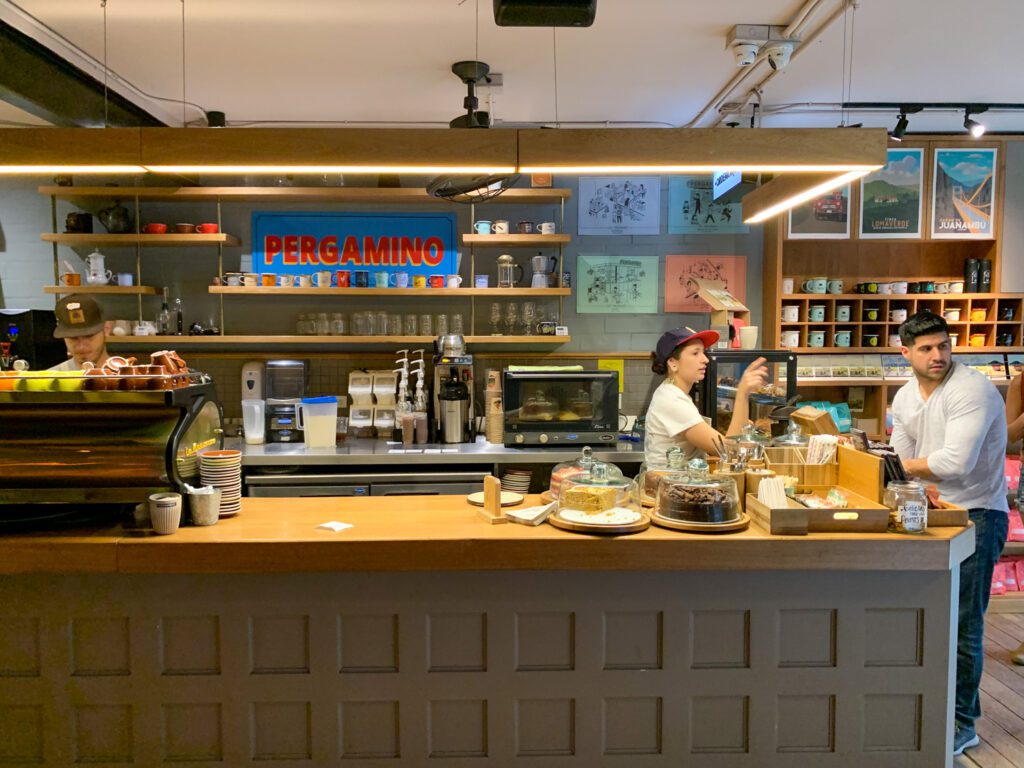

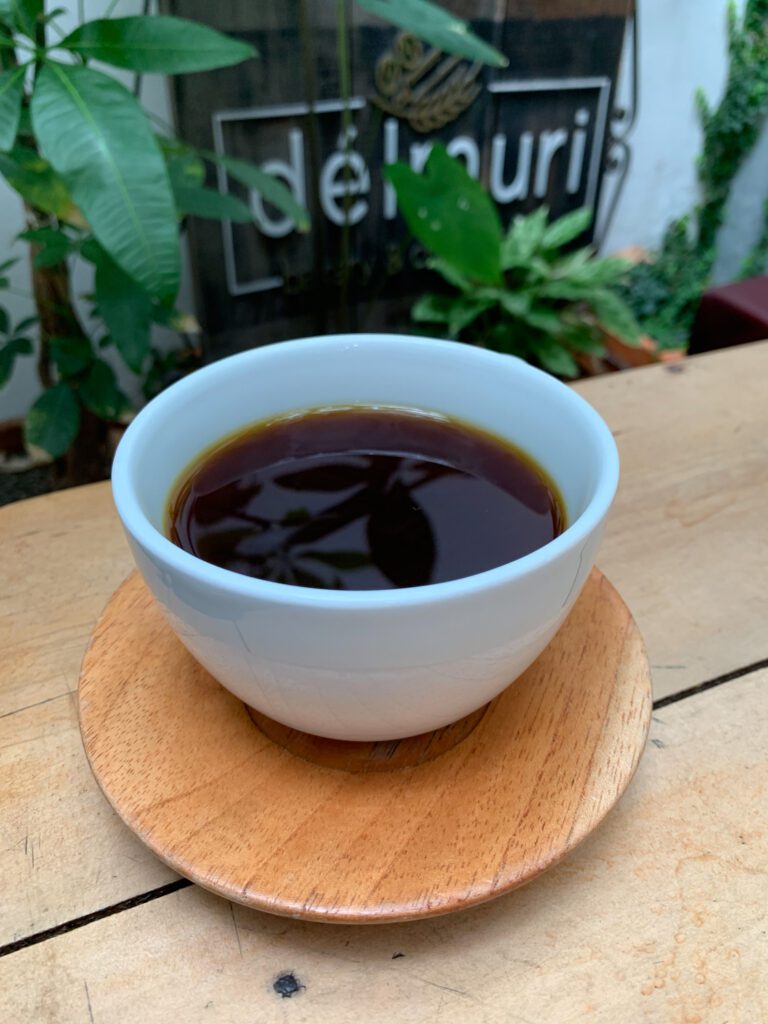
Days 11-14: Cartagena
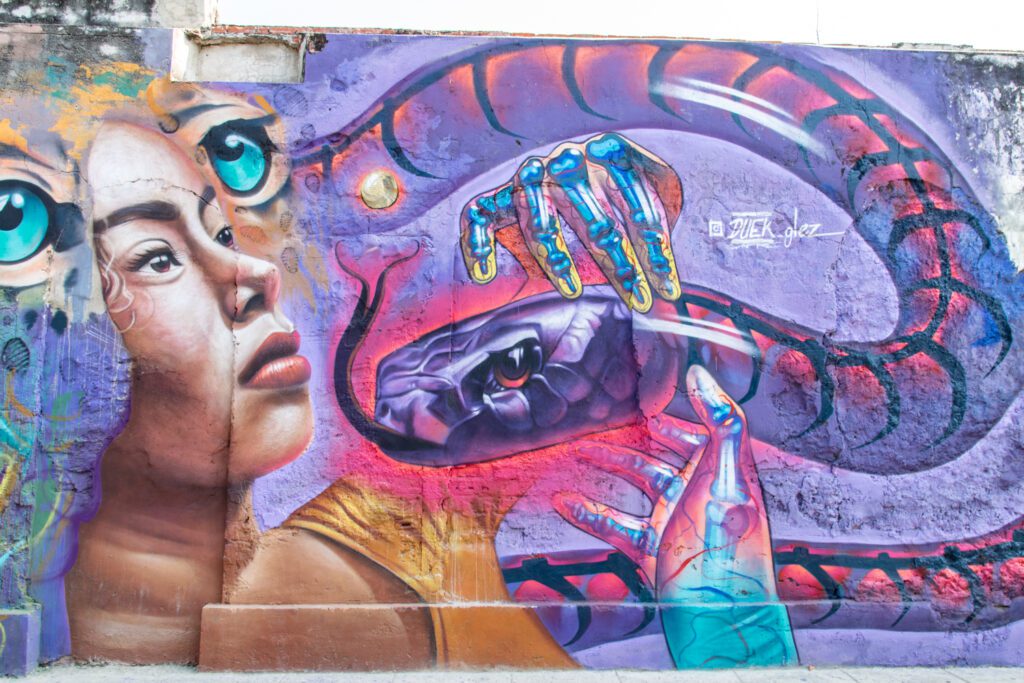
Cartagena is Colombia’s coastal gem on the Caribbean Coast, featuring colorful buildings, interesting architecture, and a pretty sad history. It was “founded” in the 1500’s (uh, it existed for several thousand years before that, when indigenous people lived here) and served as a major port for the Spanish Empire that brought African slaves to the Caribbean.
Today, Getsemani is a super hip and trendy neighborhood, with Instagram-friendly streets thanks to the umbrellas hanging above, but it was once home to displaced and enslaved people. It’s something to remember as you walk the now colorful and vibrant streets and take your photos.
With that historical context in mind, Cartagena is a gorgeous city, and is a very different experience than any of the other spots you’ve been so far.
The Afro-Carribean influences are everywhere, from the food, which focuses more on seafood, to the colorful buildings adorned with all sorts of flowers and, this may sound weird, super unique door knockers (historically, every wealthy family had its own as a kind of family symbol).
Getting to Cartagena
Cartagena is on the northern coast of Colombia, right on the Caribbean. To get there from Medellín, you need to fly. The flight is under an hour, while the bus ride is going to take 12+ hours.
Again, fly Avianca if you can. Trust us.
To get to the airport from Medellín, have your hotel call a taxi. The rate is fixed, and is going to be slightly cheaper than the journey from the airport.
You’ll fly into Rafael Núñez International Airport (CTG), which is actually relatively close to the city center compared to some of the other airports in Colombia. Hop in a taxi from the airport for the four mile ride into the city – the fare is fixed from the airport to the Walled City, and will cost about 10,000 COP (~$3.50 USD).
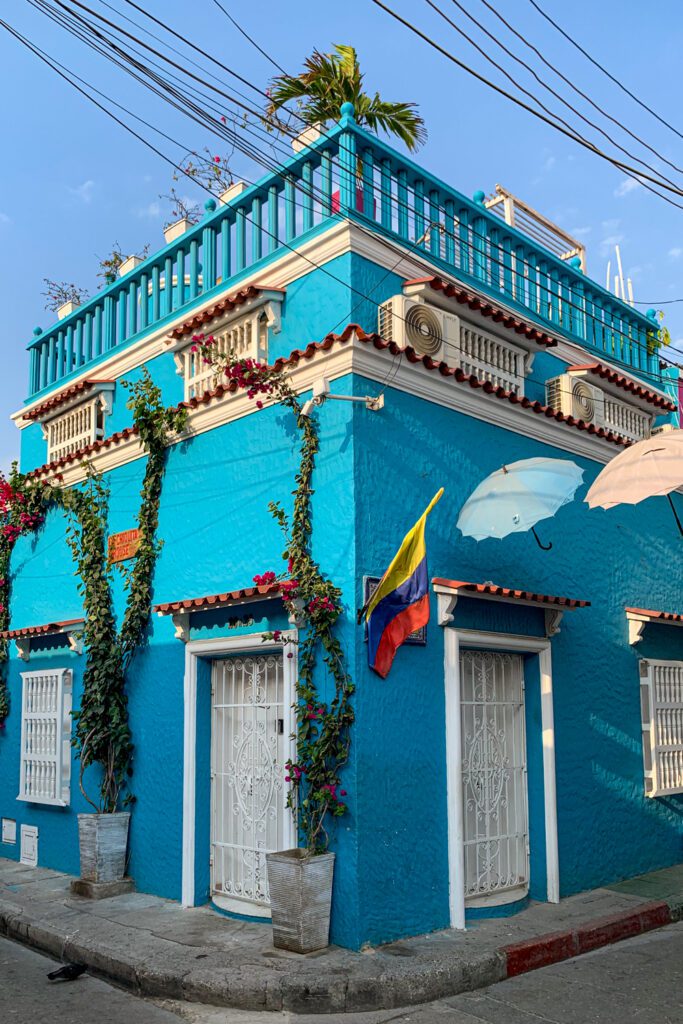
Where to Stay in Cartagena
We’d recommend staying in San Diego, which is inside the Walled City on the north side of town. It’s where we stayed, and it’s a perfect home base for exploring the city.
Whatever you do, do not stay in Bocagrande. The beach in Cartagena sounds romantic, but we found that it is very much not. Although there are some nice beaches nearby, this is not one of them. It’s also far away from the most interesting parts of the city, meaning you’ll probably be taking a taxi (or bus) to get to them, versus walking the beautiful streets of Cartagena.
Update: We have a whole post on where to stay in Cartagena, and you should definitely read that for more detailed recommendations on the best places to stay in this charming, colorful, and energetic city.
If you want a lovely and affordable hostel, look no further than Maloka Boutique Hostel, which has comfortable private rooms (with shared or private bathrooms), helpful staff, breakfast included, and a perfect location in San Diego.
Looking for a hotel in Cartagena? There are tons of options, but most of the hotels in the Walled City are on the luxury side of the spectrum – the more affordable chain hotels are out near Bocagrande AND YOU SHOULD NOT STAY THERE.
We walked through Bantu, a boutique hotel in the heart of the Walled City, because I was interested in the architecture and I had read about their story. It’s pricey, but the space is beautiful. If you’re on a budget, I’d strongly consider Airbnb or Maloka Boutique Hostel.
Still want a hotel? Click here to find the perfect hotel in Cartagena
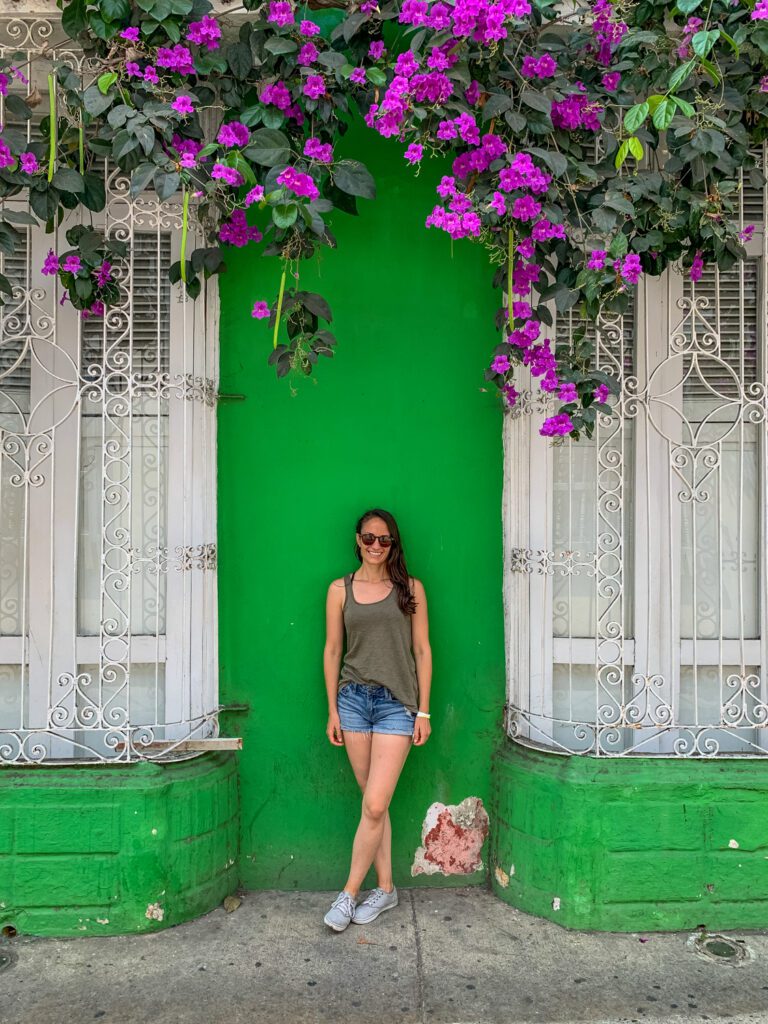
What to Do and See in Cartagena
Like other cities in Colombia, there’s a diverse group of things to do and see in Cartagena. Here are some things we really enjoyed.
Take a Street Food Tour
On every corner, you’ll find a street food vendor selling everything from arepas and empanadas to fresh-pressed fruit juices. Taste it all, and then some unusual things you wouldn’t have known to look for, on this guided street food tour with a local chef.
Learn About Cartagena’s Colonial History
On our trip, we did an amazing walking tour that took us in a big circle around the city as we learned about Cartagena’s past, present, and future. Unfortunately, that tour is no longer available, but this walking tour is the next best thing that we found.
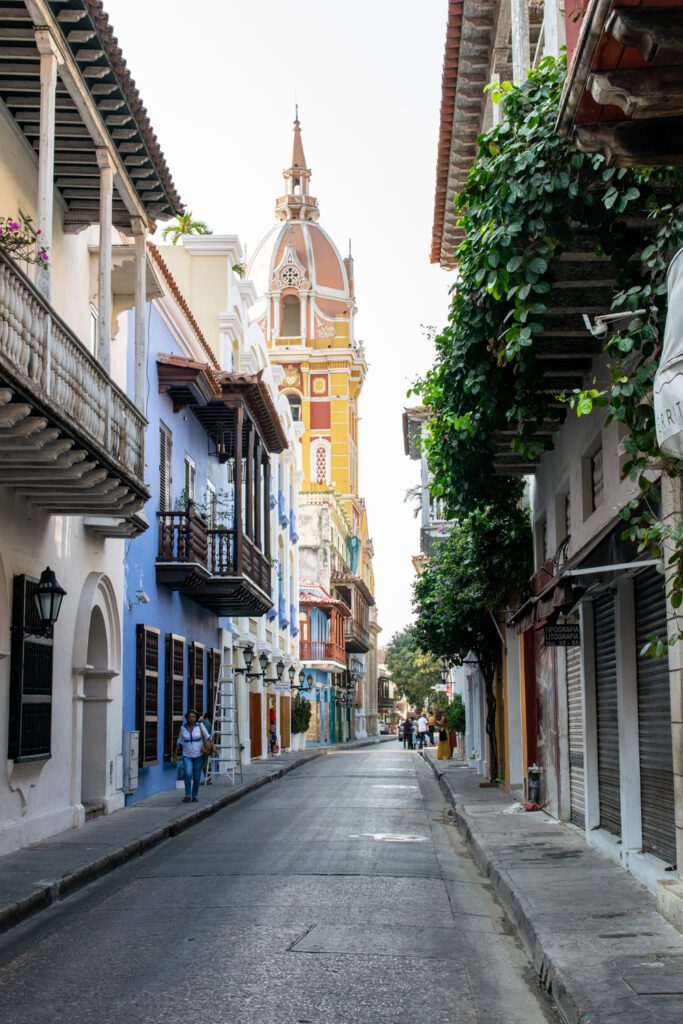
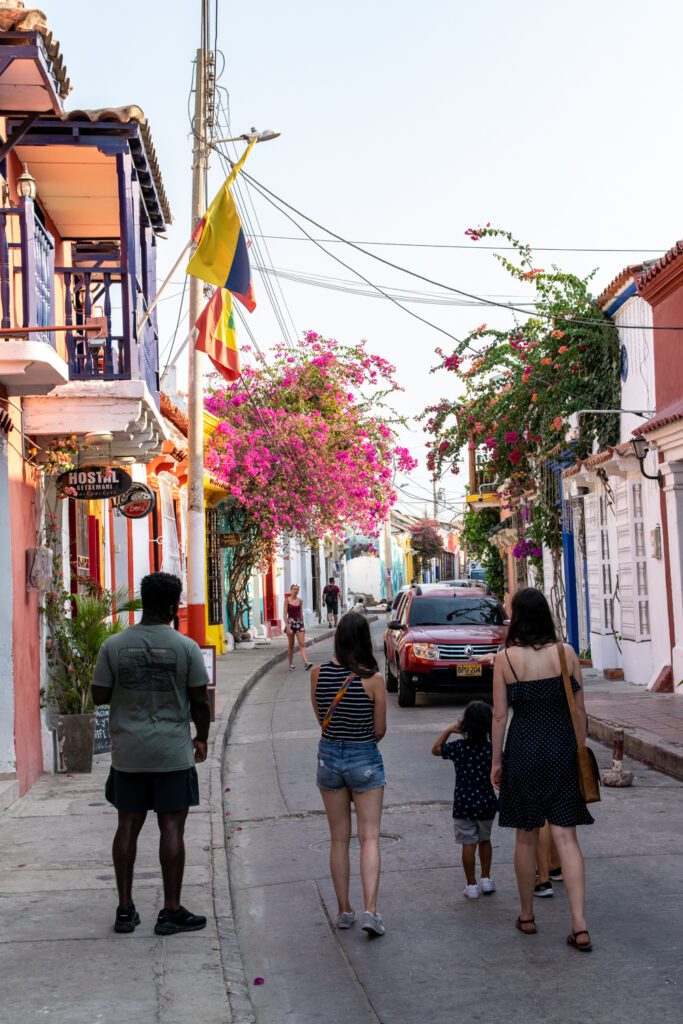
Kayak to a Beautiful Island
Unfortunately for us, we didn’t discover this kayaking experience until we started writing this guide, because it is RIGHT up our alley. Head out early in the morning to beautiful Tierra Bomba Island, which is where you’ll find pristine white sand beaches (NOT BOCAGRANDE).
It’s a super unique way to explore Cartagena and make it out to a beautiful island most tourists probably never even consider.
Take a Cooking Class
This cooking class in Cartagena was one of two cooking classes we did in Colombia (you read about the other one we did in Medellín), and it was fantastic.
We learned how to make arepas de huevo, fish baked in plantain leaf, and SUPER sweet coconut rice with a friendly husband/wife duo in their restaurant in the middle of Cartagena.
It was super cool to connect with other travelers and learn about their experiences in Cartagena and the rest of Colombia too.
Explore Bazurto Market
The biggest market in Cartagena, full of food vendors, fresh produce, and more, is best explored with a local. This tour takes you to the market to try some of the foods and fruits that the market has to offer, while giving you an insiders perspective on the city’s history and important issues in Cartagena today.
If Anthony Bourdain did it, I usually want to do it.
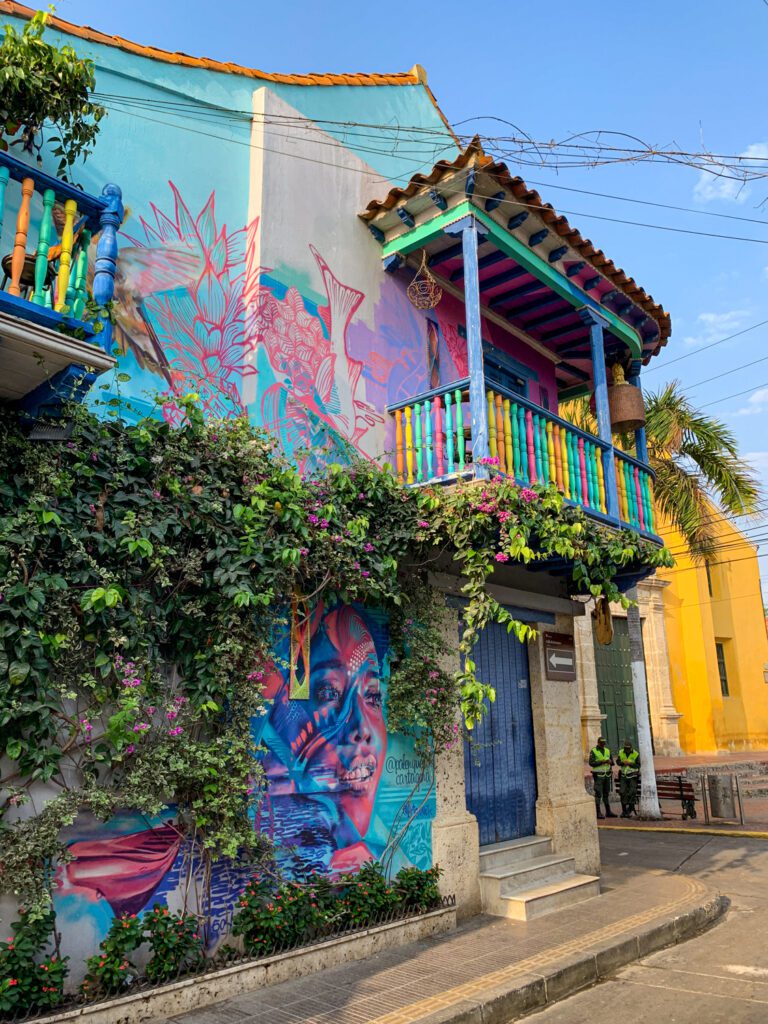
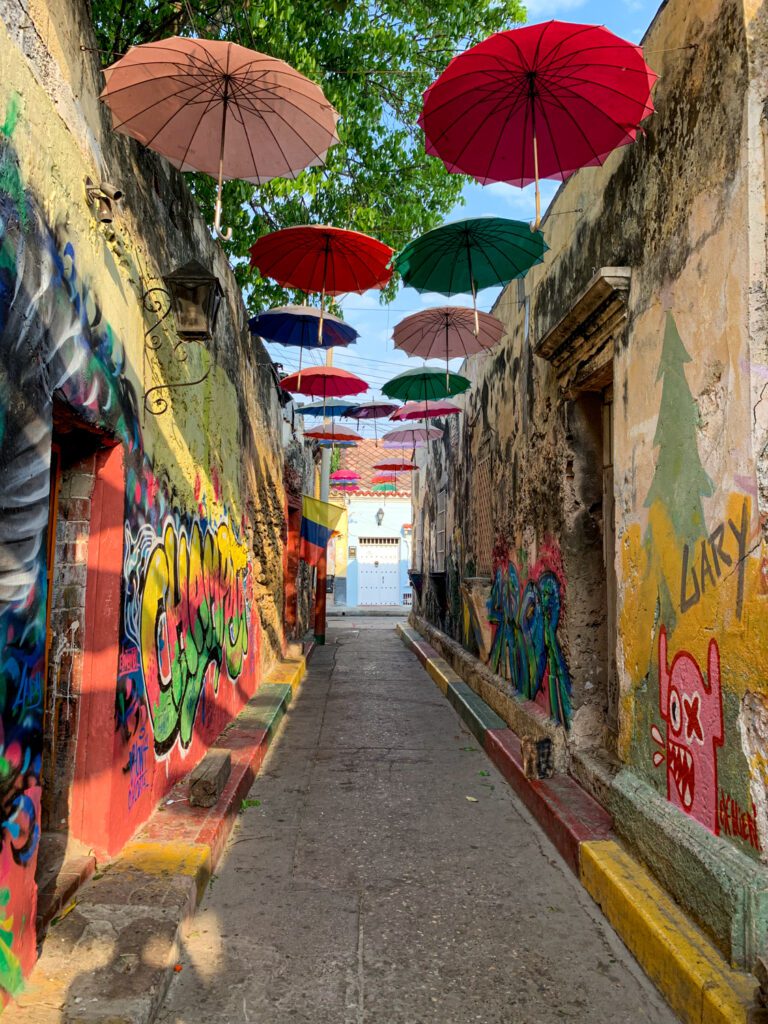
Where to Eat & Drink in Cartagena
So Cartagena was a tough one for me, Matt, as someone with Celiac Disease. That means that I truly need to avoid gluten at all costs, and I found that a little bit hard to do in Cartagena. Lots of fried food in fryers/pots that also fry gluten, and lots of soy sauce (which is not gluten free) used in marinades.
I had success at Stepping Stone Cafe (that black bean stew is fantastic), Pezetarian (100% gluten free ceviche) and Quero Arepas (Venezuelan-style stuffed arepas), but had trouble feeling comfortable eating elsewhere.
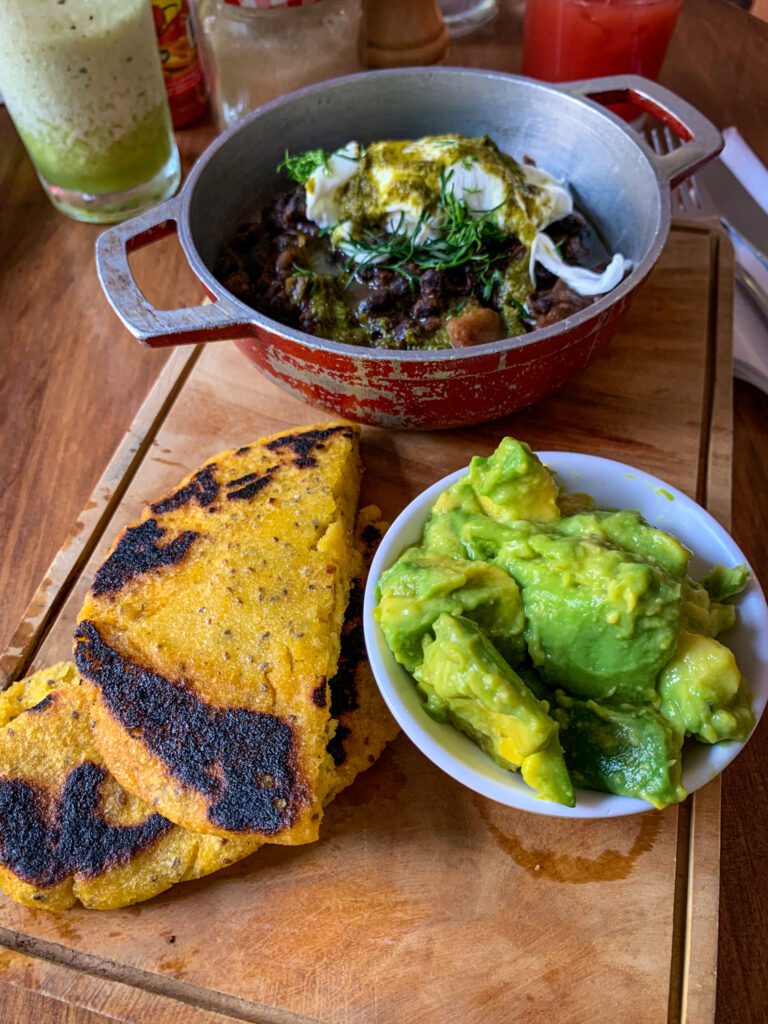
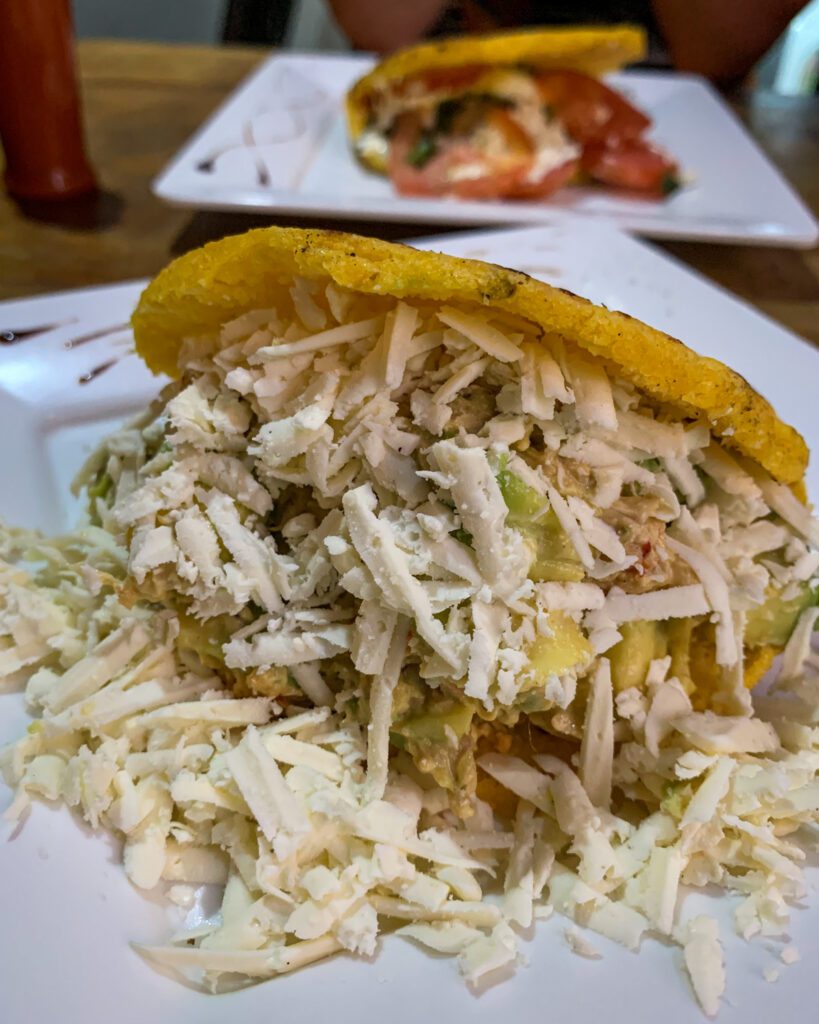
So we largely cooked for ourselves, going to the market and store and getting some fresh fruit, plantains, avocado, eggs, and more. In general, if I’m not sure I can eat safely, I opt to avoid it rather than risking being sick for days.
However, that certainly does not mean you, a non-Celiac, can’t eat delicious food in Cartagena.
Here are a couple of resources to help you find amazing food on your trip:
The best coffee in Cartagena can be found at Epoca Espresso Bar, where you’ll be able to choose from all sorts of offerings from pour over to espresso drinks.
For a cool atmosphere (but coffee that wasn’t as good), head to Abaco Libros y Cafe. Pro-tip: that’s also where you’ll find the best view in Cartagena.
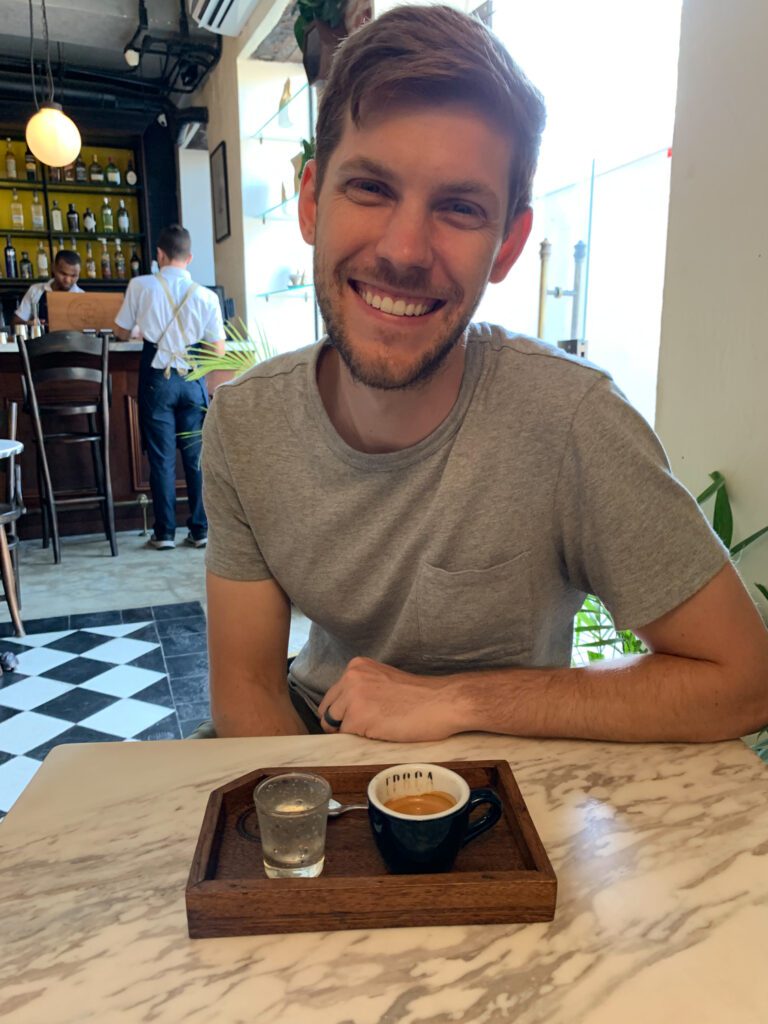
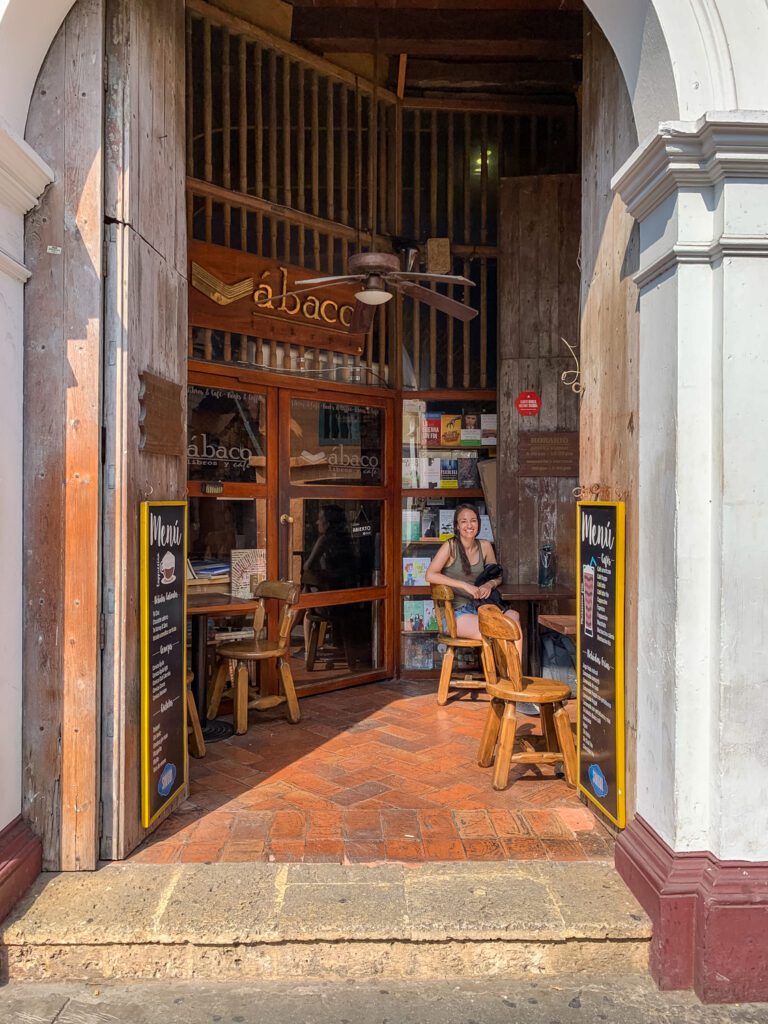
For cocktails and a fun night out, do not miss Aquimilco, a hip and happening three story cocktail bar with a rooftop. The ground floor has speakeasy vibes galore, and the rooftop was packed when we were there on a random weeknight.
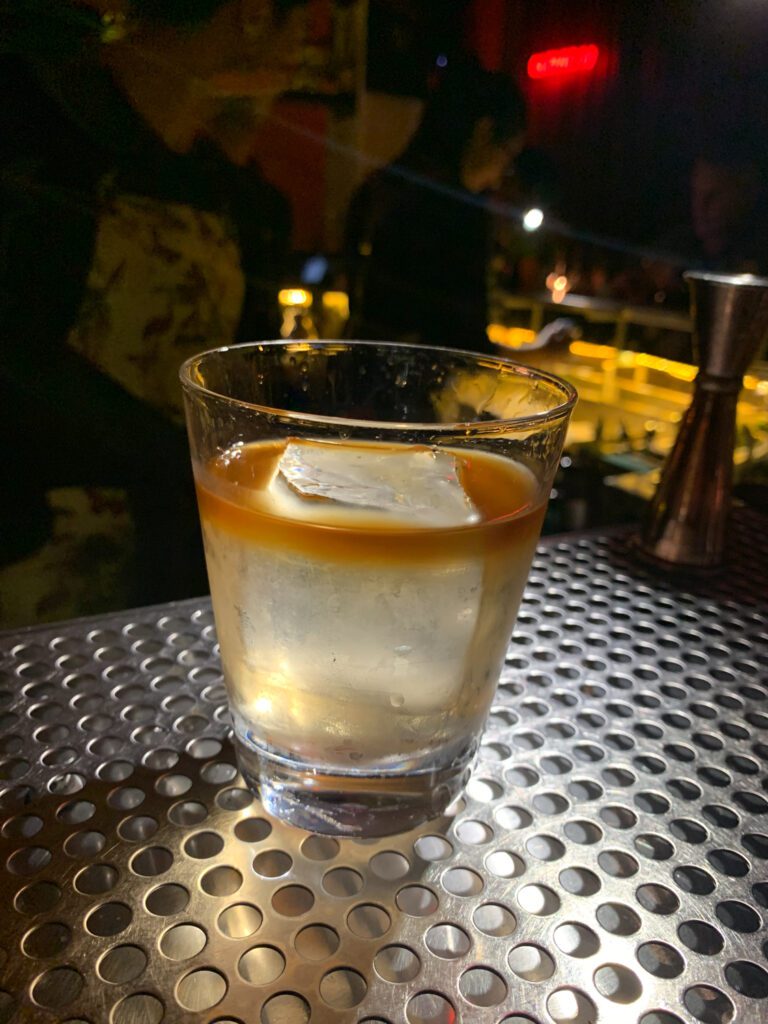
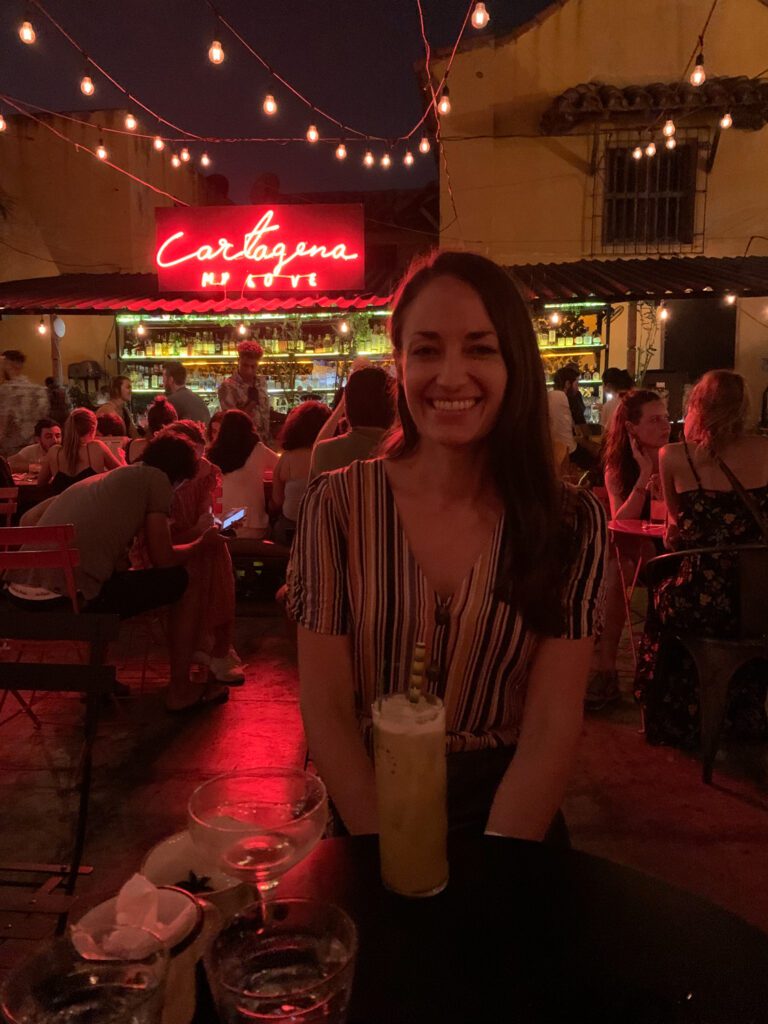
What to Do with More Time in Colombia
Lucky you! You probably have enough time to make it to one or two of our favorite spots in Colombia!
This is a list of other places to add, along with how much time to spend there, in order of our recommendation. In other words, from best to Minca.
I touched on the trek to La Ciudad Perdida (“the Lost City”) above, which is a four to six day adventure through the jungle to an ancient city that dates back further than Machu Picchu in Peru. If you want to add that, it’s going to be at least five to seven days including getting to Santa Marta and doing the trek.
Jardín (2 Days / 1 Night)
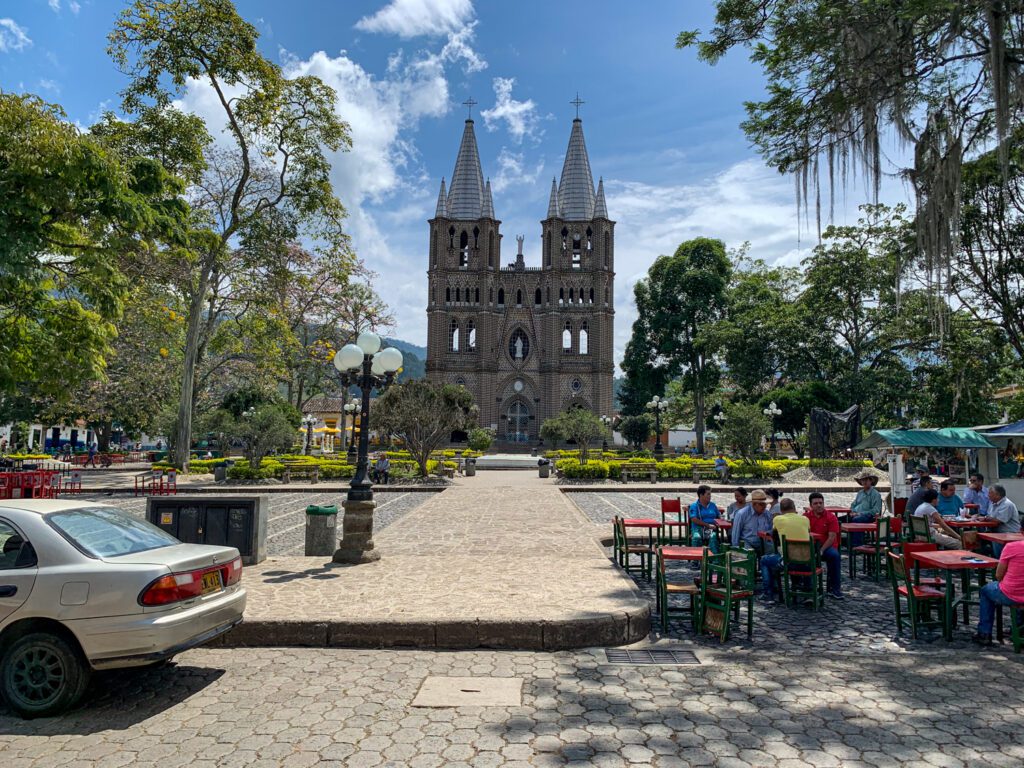
We fell in love with Jardín as the bus crested the hill above it and started down into the valley it sits in. It’s lush, green, charming, and the architecture is gorgeous (so colorful!).
It’s south of Medellín in Colombia’s Antioquia department in the Andes Mountains. A lot of people recommended Minca, which turned out to be a bust (you’ll find it at the bottom of this list), but a couple of people we talked to said to go to Jardín, which we had never heard of before, and it was a gem.
Bright colors adorn the buildings lining the bustling streets make for exquisite photos, as do the cowboys enjoying their morning coffee on the main square.
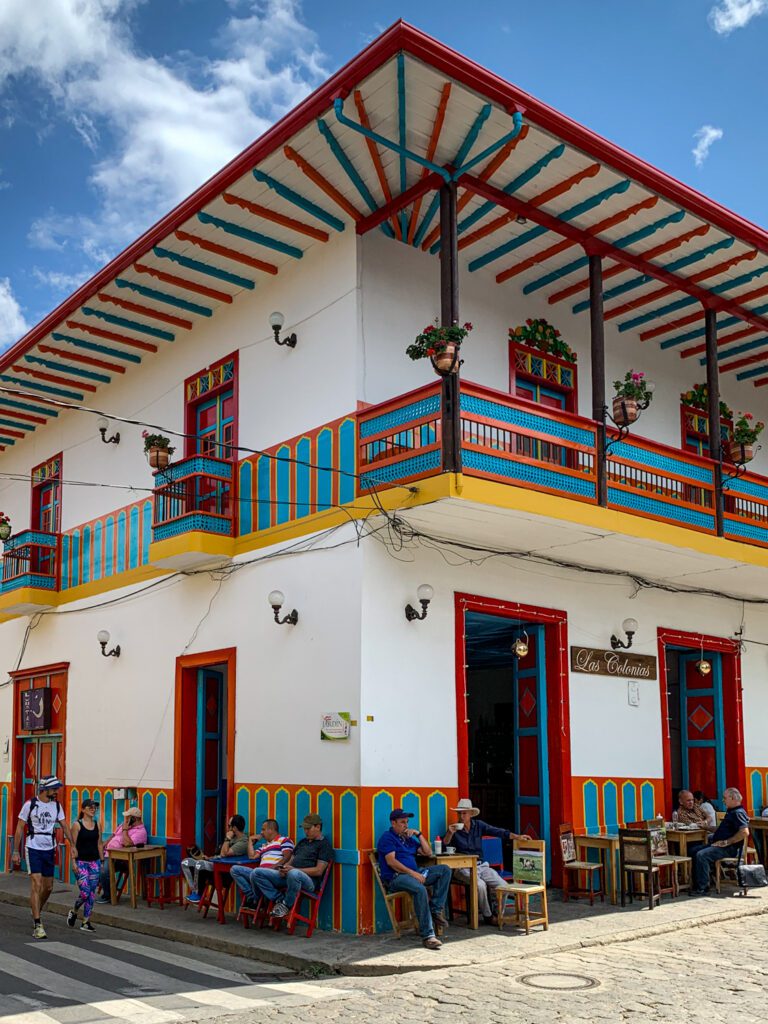
Oh, and the hike up to Café Jardín situated on the hill above town is not to be missed.
Getting there is a bit of a journey, unless you do it from Medellín, which is what we would recommend. Even then, plan on four to six hours. You’ll take the bus from Medellín’s Terminal de Sur.
We used this guide to plan the journey, and found it invaluable.
Parque Tayrona (2 days)
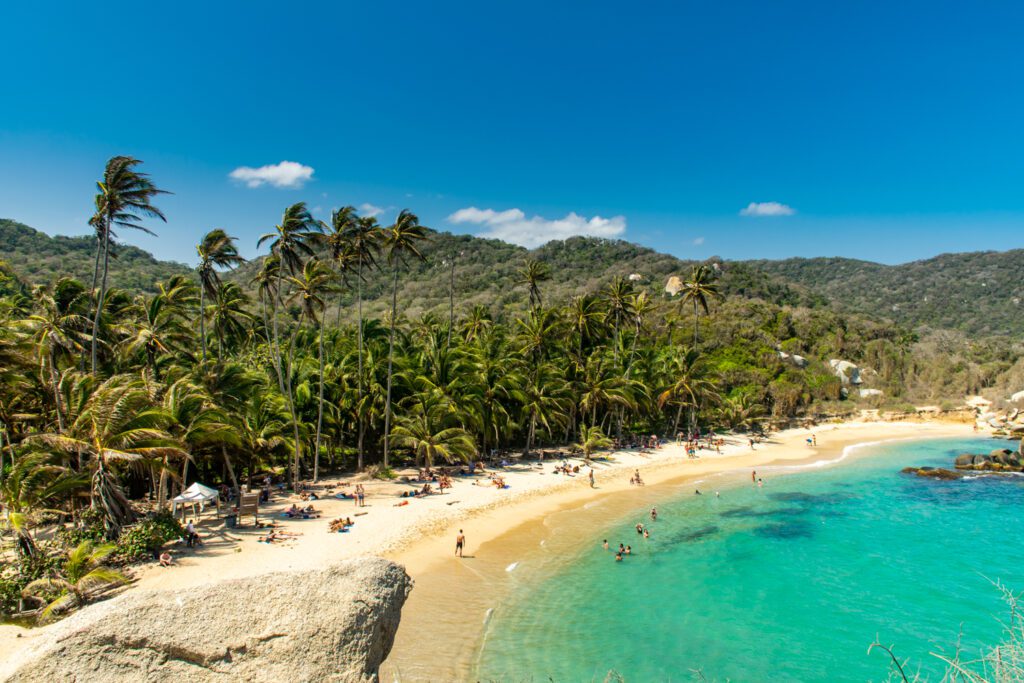
For real, Parque Tayrona is gorgeous. White sand beaches. Palm trees. Crystal clear water. Paradise.
It’s a little bit hard to get to, but if you add it in before you go to Cartagena, which is what we did, it’s not too bad.
You’ll need to fly into Santa Marta, taxi to the bus station at the Central Market, then take a bus out towards Parque Tayrona. Here is a guide on how to get there.
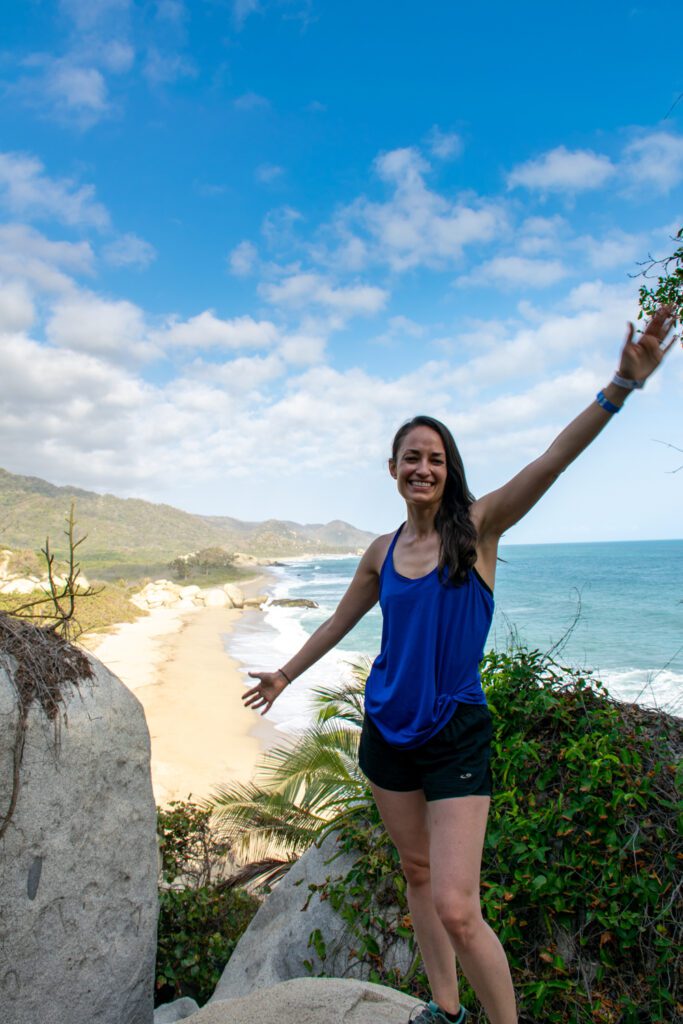
Theoretically, the best way to do it is to camp on the beach at night, but it’s also not a great experience based on what we heard from other travelers – dirty tents, packed in like sardines, wet and unwashed sleeping bags, etc etc.
We’d recommend a day trip into the park, which is what we ended up choosing.
You’d need to spend two nights, arriving the night before you enter the park (stay at Eco Hostal Yuluka). Then start early in the morning and enter at the El Zaino entrance, hike out to Cabo San Juan, relax on the beach and do a bit of exploring, and then exit the park and stay another night at Eco Hostal Yuluka, which was our favorite hostel in all of Colombia. Mostly because of the water slide.
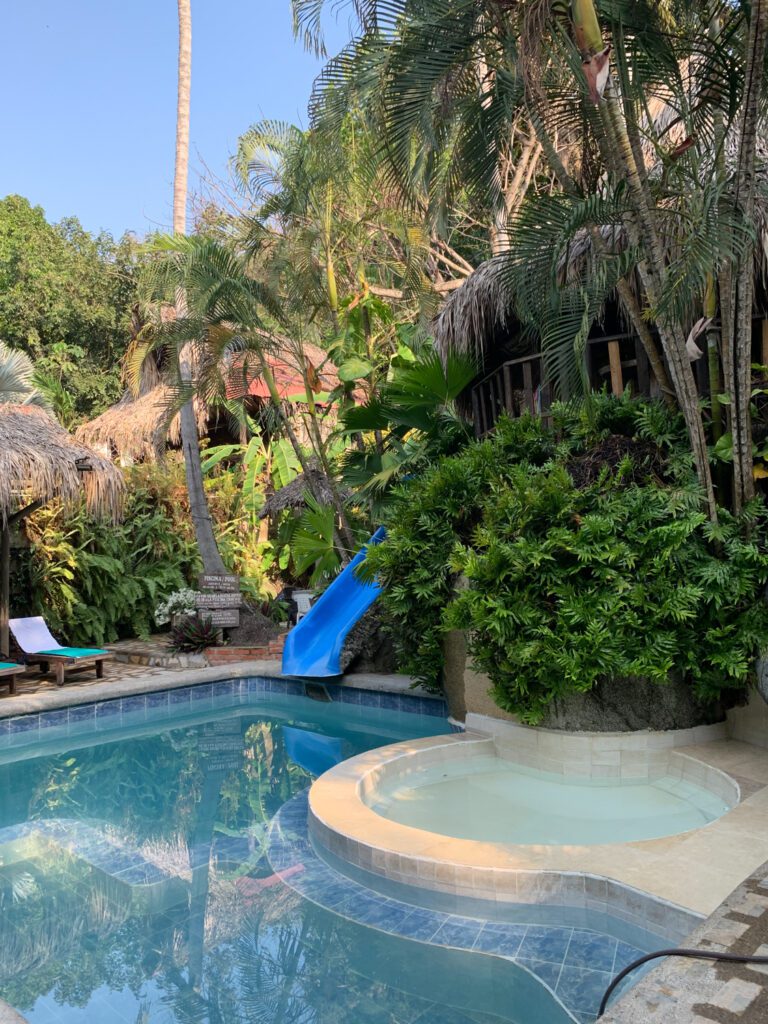
Then get up the next morning and catch the bus back to Santa Marta, and then onwards to Cartagena.
Filandia (Day Trip from Salento)
Since we had a full week in Salento, and there’s really only about four days of things to do in Salento, we ended up with an extra day or three. And we decided to get out of town and head to Filandia, a similar but definitely less famous town about an hour away. And we’re glad we did.
It’s much quieter than Salento, and is home to one of the best restaurants we ate at on the entire trip – Helena Adentro.
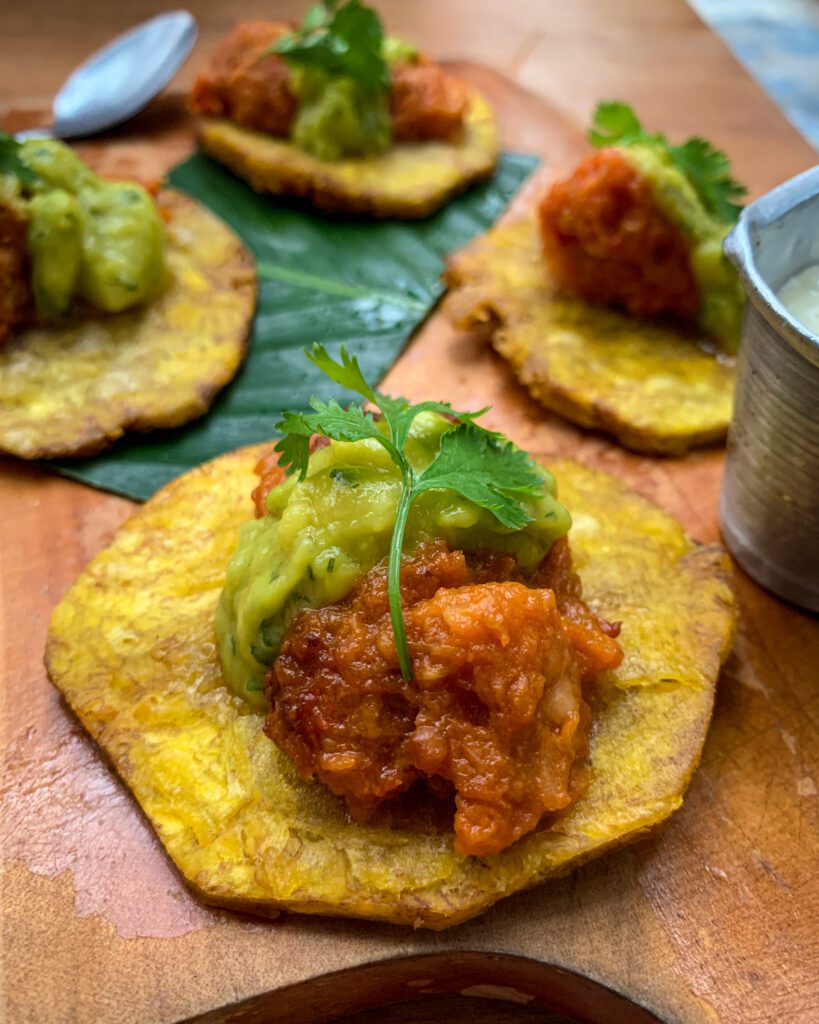
In addition to food, you’ll want to make it out to the Mirador de Quindio, which has fantastic views out over the countryside.
Here’s a guide on getting to Filandia from Salento, which involves getting a bus towards Armenia, getting dropped on the side of the road, crossing a major highway on foot, and catching a different bus to Filandia. Adventure!
Guatape (Day Trip from Medellín)
We didn’t do this, since we had already done the trip to Jardín, but many people head to Guatape to climb the huge rock. You can either do it yourself (read this guide), or take a guided tour from Medellín.
San Gil (2-3 Days)
This is another spot that was a “we’ll have to come back” situation, but we read that it was the adventure capital of Colombia and our ears immediately perked up.
It’s in the Andes, to the north of Bogotá, and is full of all sorts of outdoor adventure activities, from mountain biking, to river rafting, and paragliding. Here’s a guide to the best things to do in San Gil, since we didn’t actually go.
Minca
We read all about Minca, an up and coming bohemian backpackers paradise. And we were stoked to go there. Turns out, it’s not all it’s cracked up to be. We had two of the worst tours we did in all of Colombia there that were clearly designed to appeal to tourists, and in general the vibe was not great.
It has become a victim of its own publicity, and we don’t think it has the same charm it did five years ago when every travel blogger and their mother proclaimed that it was their favorite spot in Colombia. We spent five days there, and we wouldn’t go back.
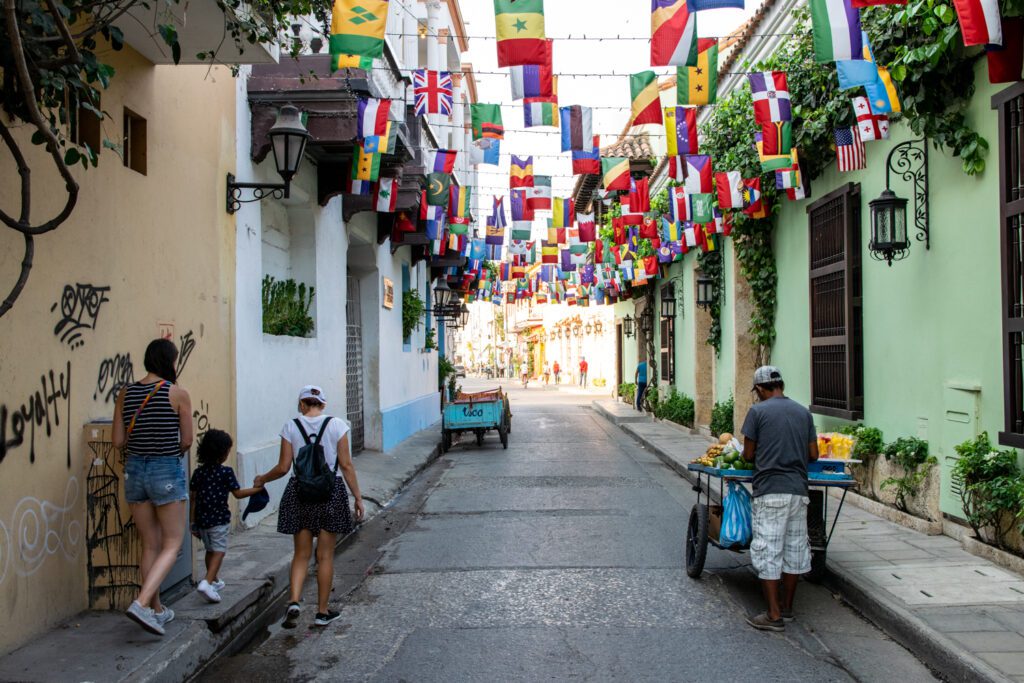
What to Eat and Drink in Colombia
Colombian food is delicious, diverse, and affordable.
It’s worth pausing on the diversity front, because the food culture in Colombia is so incredibly different across its different regions.
A good illustration would be “arroz de coco” – coconut rice – which you’ll find nearly everywhere in Colombia as a side dish. In Medellín and Bogotá, we found it to be more savory, with just a little bit of panela (unrefined cane sugar) added. Once we got up to the Caribbean coast, in Cartagena and Parque Tayrona, BOOM ALL THE SUGAR. We did a cooking class in Cartagena, and I think we added seventeen pounds of panela to the recipe (vs. a quarter cup in Medellín).
Arepas: If you’ve followed Alysha and I, you know we LOVE arepas. Colombian arepas are generally flat, and served as a side. What you usually find in the US and Europe are Venezuelan-style arepas, which are stuffed full of all sorts of goodies. That being said, in Cartagena you’ll find arepas de huevo, which is an arepa stuffed with an egg and deep fried (aka yum). You’ll find arepas everywhere, and I would be flabbergasted if you spent two weeks in Colombia and never came across an arepa. It’s worth seeking out arepas de choclo, a sweeter arepa made of a specific kind of corn, and served topped with salty cheese. Oh, and arepas de yuca relleno con queso (stuffed yuca arepas with cheese in the middle) are incredible too – you can find them at most supermarkets.
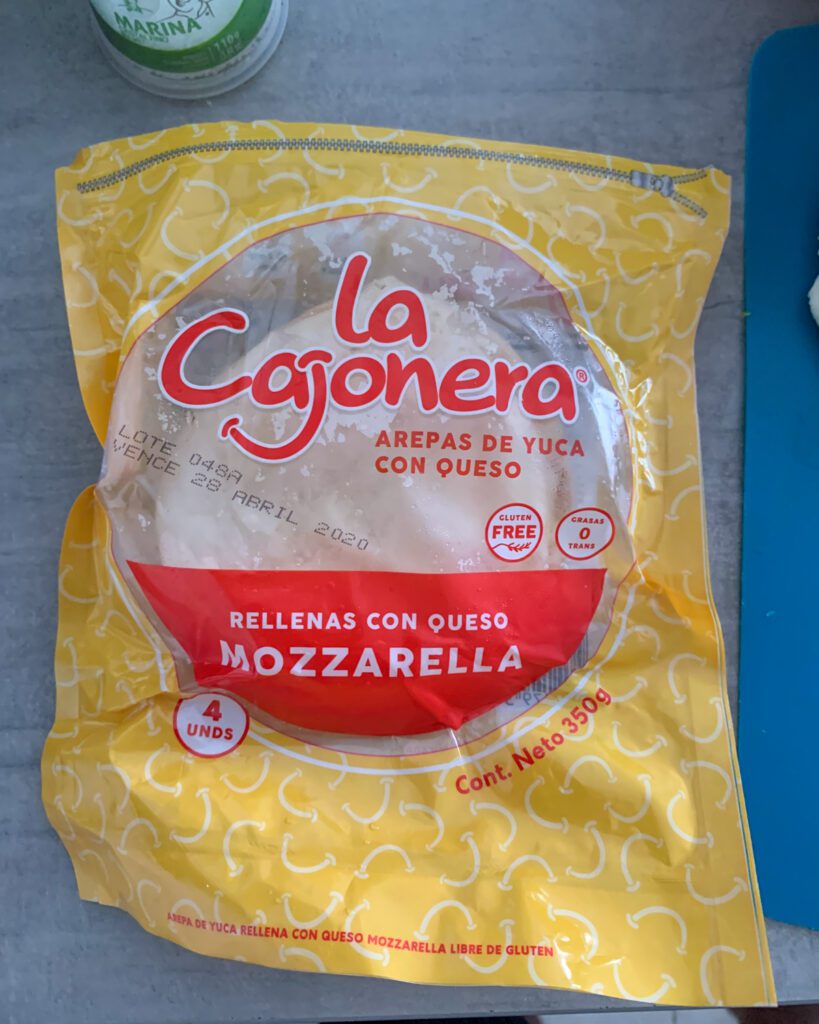
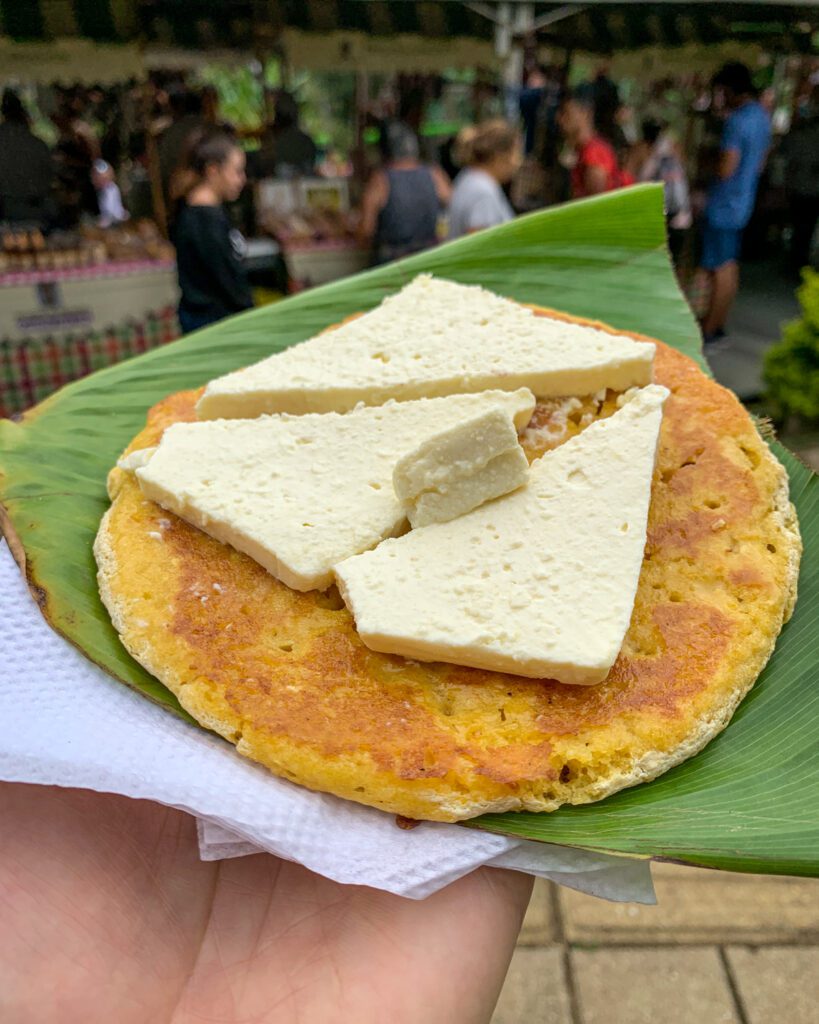
Patacones: We now have these at home all the time after the cooking class in Cartagena taught us how to make them (previously, we couldn’t figure out the order of operations for mashing them). Basically, it’s plantains that are boiled, flattened, and then fried. And they’re delicious. You’ll find them as a side dish basically everywhere in Colombia.
Ceviche: Colombia loves its ceviche, particularly up on the Carribean coast. Still, you’ll find ceviche all over the country, even in mountainous Bogogota.
Chocolate con Queso: Yep, you read that right. It’s essentially hot chocolate with cheese. You have to try it while you’re in the Andean region.
Trout: The Quindio department, which is home to Salento, is full of trout fisheries. On every menu in Salento you’ll find “trucha” – Grilled, fried, plantain crusted, topped with cream sauce, and nearly everything in between. When you’re in Salento, you have to order trout, which will probably be served with coconut rice and patacones.
Soup! Ajiaco and Sancocho, in particular. Ajiaco is native to the mountainous, and therefore colder, region around Bogotá. It’s a stew that is made with a combination of multiple kinds of potatoes, chicken, and corn. Sancocho is similar, but is made with yucca and plantains in addition to potatoes. This is another good example of Colombia’s incredible diversity – the soups in mountainous areas are made with a thin, savory broth and are stuffed with chicken and root vegetables, while seafood soups up on the northern coast, where coconuts are everywhere, use coconut milk as a base instead.
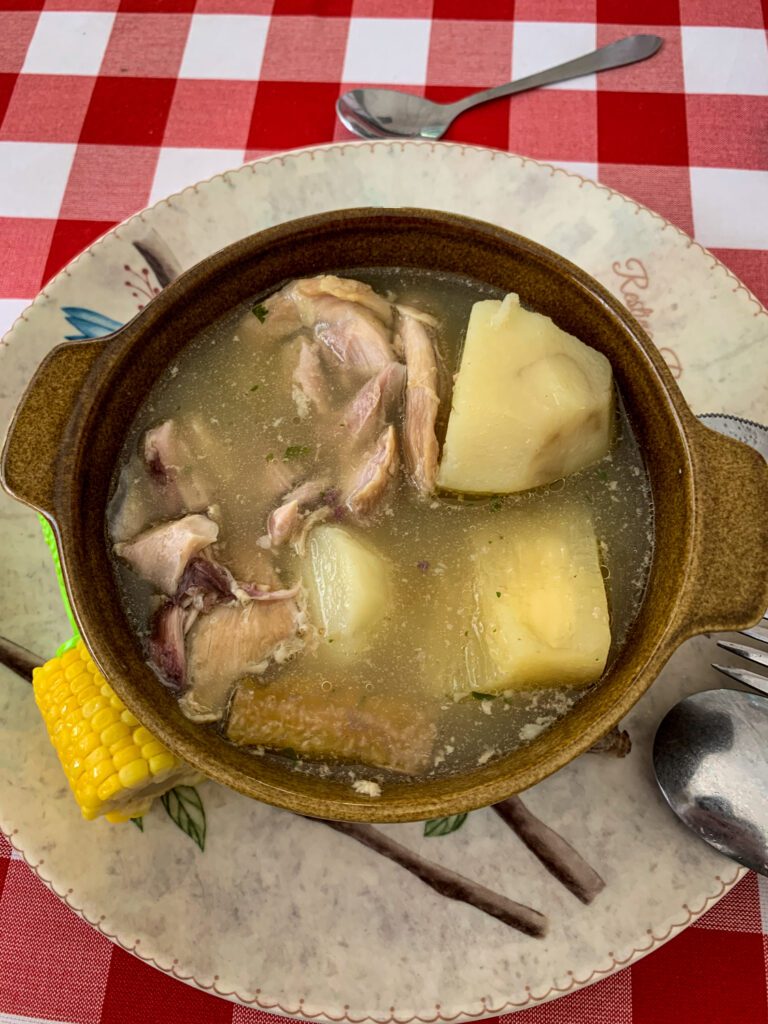
Empanadas: In Colombia, unlike many parts of Latin America, empanadas are made with corn rather than flour, which is amazing. Then they’re stuffed with everything from potatoes and veggies, to cheese, and of course all of the meats. They’re ideal street food, because you can get a couple as you’re walking around and eat them with your hands. Though they can be greasy.
Guarapo: Fresh pressed sugarcane – like, you watch them press it with a cool machine – mixed with lime juice. Absolutely delicious.
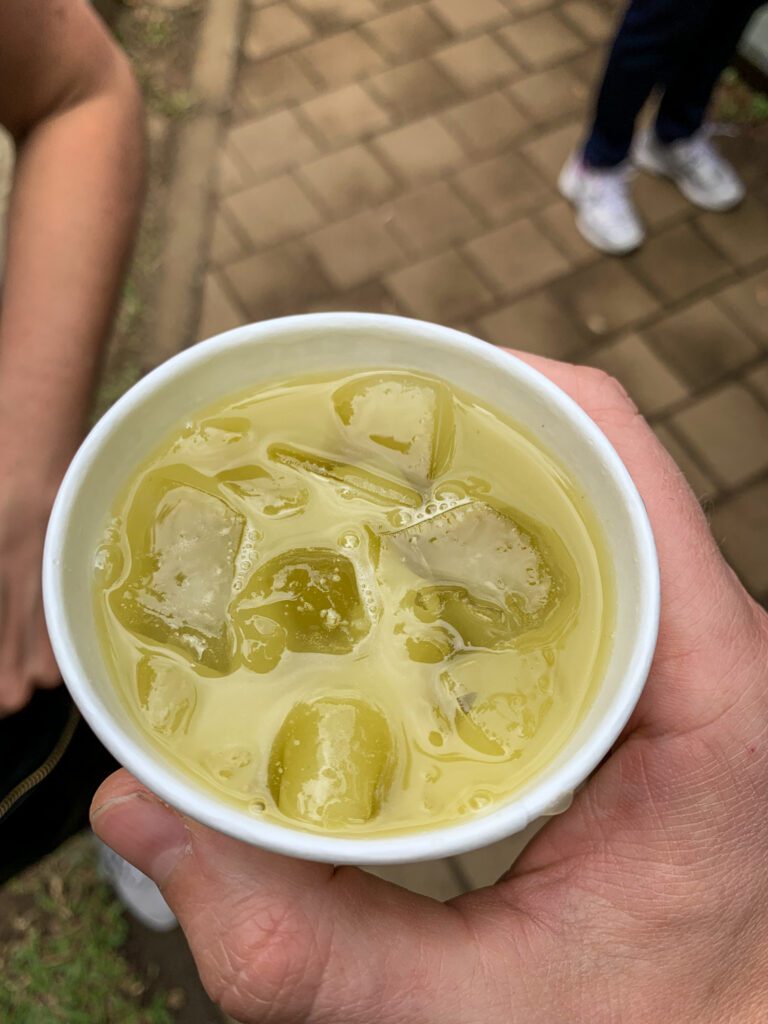
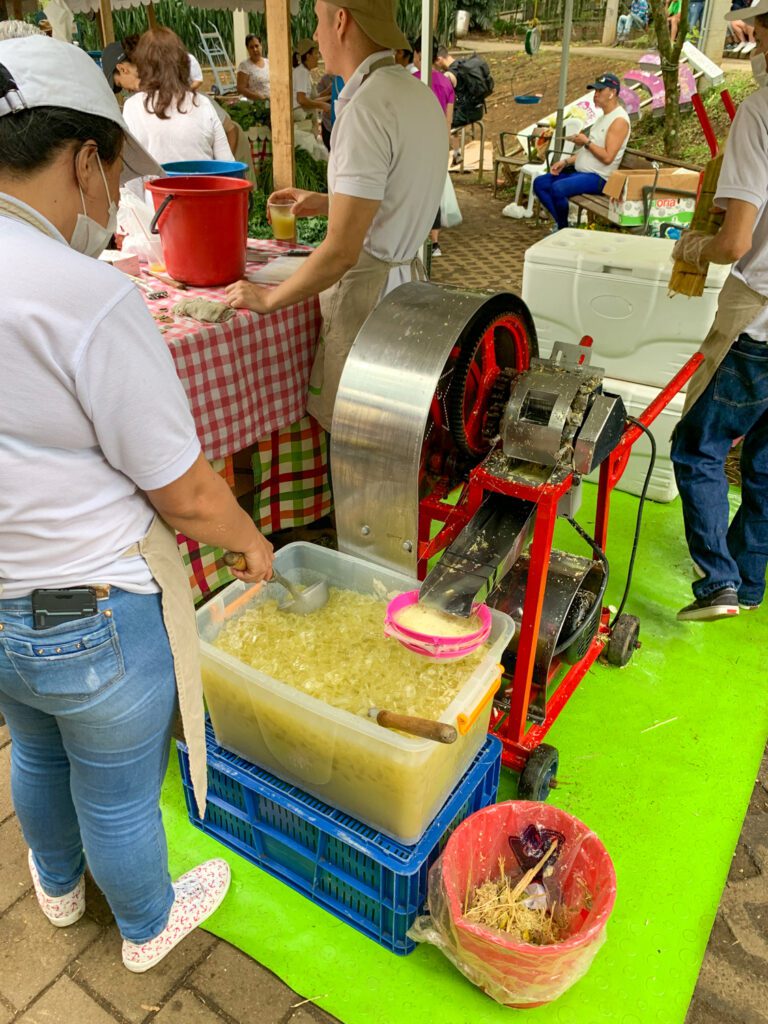
Fruit Galore: Colombia has an incredible, dazzling array of fruits. Living in California, I generally think we’re pretty spoiled when it comes to amazing produce. But it’s nothing in comparison to Colombia. One of the experiences that we constantly bring up when we talk about our trip to Colombia is the fruit tour that we did in Bogotá. We went to Paloquemao Market, which is the massive market where all the produce comes into before being distributed to stores and restaurants in Bogotá, and spent three hours tasting ALL THE FRUITS. Which was amazing, because we were with a local college student who knew all about the different kinds of fruit and how to eat and pick them. Usually when we go to markets like that alone, we walk around for ten minutes, go “wow that’s a lot of fruit” and move on because we have no idea where to even start. If you have the time, definitely do a fruit tour in Bogotá or in one of the other stops on your trip.
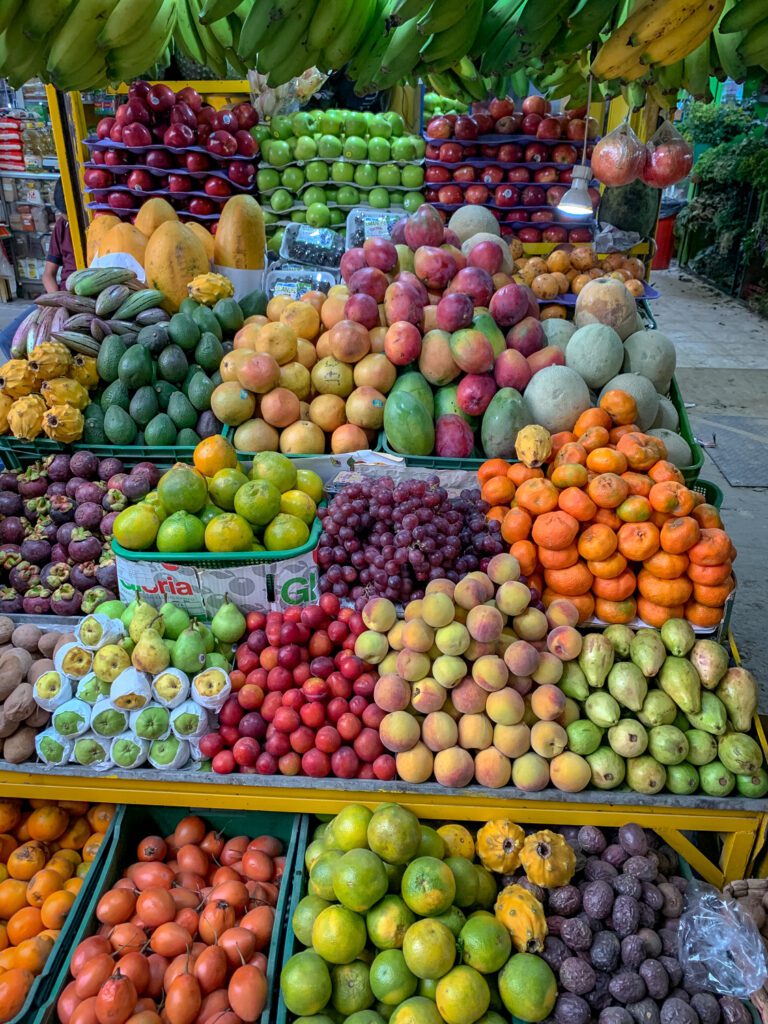
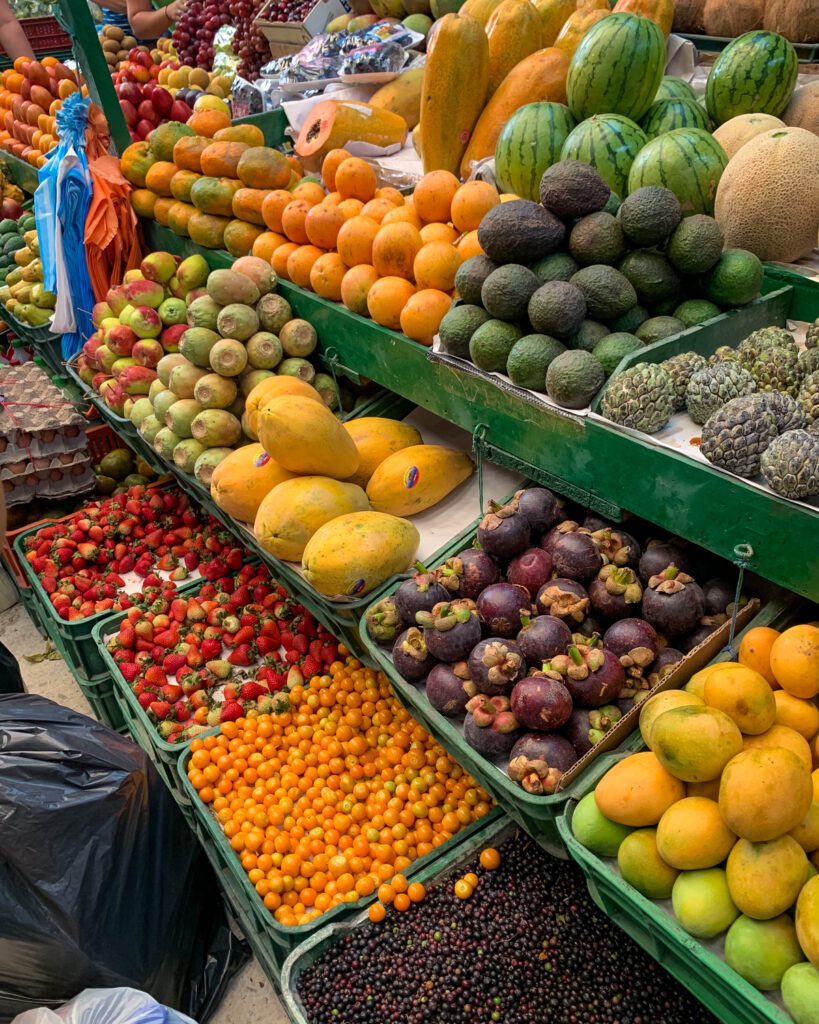
Here are a few other notes on what to eat and drink in Colombia.
- If you see fruit, eat it. The fruit in Colombia is spectacular, putting even the best fruit in Southern California to shame. We ate mango and plantain almost every day of our six weeks in Colombia.
- Most food items are sweet, fried, or both. As someone with Celiac Disease, the fried part was a little difficult for me to navigate (Need to eat gluten free? Read my gluten free guide to Colombia).
- Fruit juices are sometimes sweetened with EXTRA sugar (WHY?!) and are sickeningly sweet, though not always. I’d still recommend drinking all the fruit juices you can get your hands on, particularly papaya and guava. YUM.
- Cook for yourself. There’s a bounty of fresh produce, eggs, and more at local markets and supermarkets.
- Colombian cheese sucks. The end.
Is Colombia Safe?
In a word (or two), kind of.
First of all, I want to make it super duper clear that this is an evolving and incredibly complicated question that we don’t have all the answers to, but we do have six weeks of experience traveling around Colombia as a tourist, like you’re about to do.
Like most other travelers, the reaction when we told people that we were going to Colombia was almost a unanimous “Oh my God! Is it safe to go there?” It was like the reaction we got when we said we were going to Mexico City, but on steroids. Particularly among the over-40 crowd.
And it’s no surprise, really. Colombia’s tragic history of war and violence has been all over the airwaves for decades. Medellín was named the most dangerous city in the world as recently as the early 90’s!
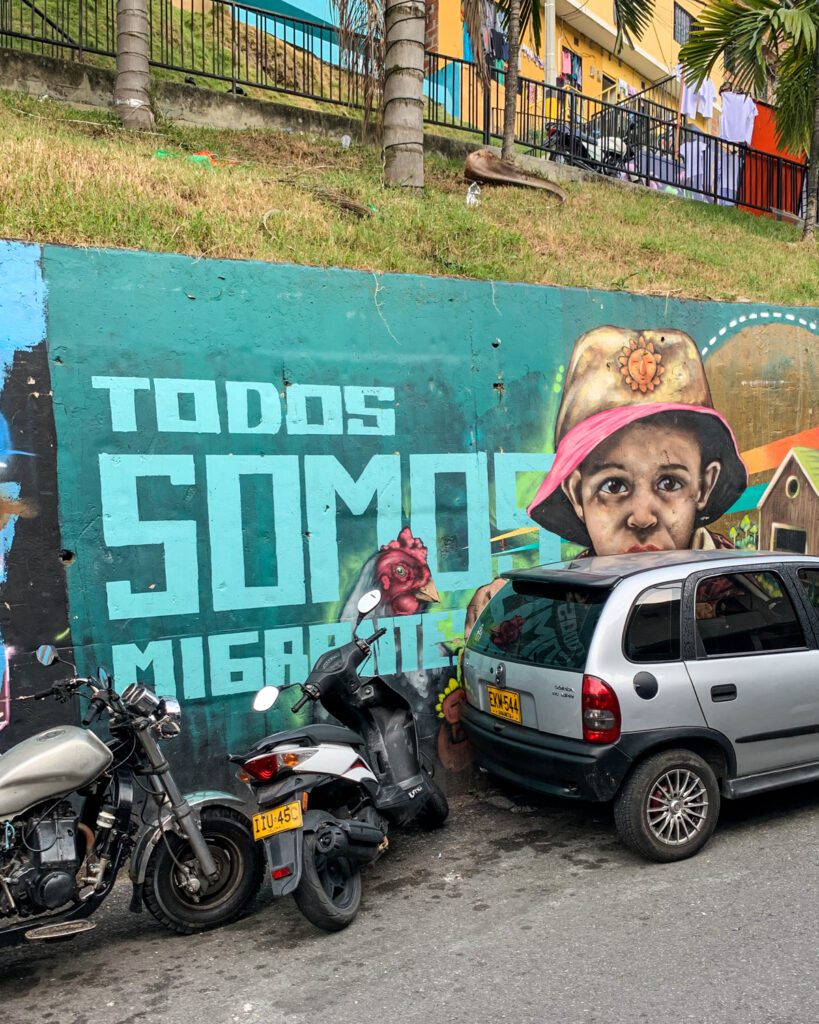
But Medellín is actually the best example of how Colombia has changed in the past 20 years.
Medellín is a fascinating city, and I think it’s a lighthouse on a hill for cities wondering if investing in infrastructure projects has long-term benefits.
They have poured money into projects to connect the outer parts of the city to, as Sebastian – a guide on the best walking tour in Medellín – put it, bring opportunity to other parts of the city.
Now, a robust above-ground metro system connects to trams and GONDOLAS that connect the poorer areas up on the hills to the downtown core, where the job opportunities and many of the community services are. They’ve also invested in institutions like libraries, schools, and community centers in some of the poorest neighborhoods (can you imagine the US doing that?).
Over the past 25 years, Medellín has transformed from one of the most dangerous cities in the world to one of the most innovative and forward-thinking.
That being said, Colombia still has issues with armed paramilitary groups in parts of the country. Make sure to check travel advisories before your trip. The areas in the southwest and northeast are places you should probably avoid, along with most of the Pacific Coast, at least at the time of writing.
Like all big cities, places like Bogotá, Medellín, and Cartagena all have parts that you shouldn’t spend too much time in as a tourist, especially at night. Ask tour guides and hotel/hostel staff for tips on where to go, and where not to. We also were told in Bogotá that taking a taxi after dark is something you should avoid – use the rideshare apps like Uber or Beat (a local Uber) instead.
Also like all big cities, petty crime is the biggest issue you’ll run into. Keep your phone and other valuables put away in public, keep your wits about you, and you’ll likely be fine.
Final Thoughts
Writing this made me say “I want to go back” about seventeen times. Colombia is a country full of beautiful, diverse people, landscapes, cultures, foods, and probably some other things I’m missing. Whether you’re looking to explore a huge urban metropolis, or relax on the beach or in a rustic mountain town, you can probably find it in Colombia.
This guide is based on our experience, and didn’t even cover places like Cali and Popayán, or Barranquilla or the Tatacoa Desert. Or the Amazon Rainforest!
There are so many amazing places in Colombia to explore – all that you’re going to be thinking after your two weeks in Colombia is when to book your flight back.
Planning a trip to Colombia? Don’t miss our other Colombia travel guides, based on our six weeks of galivanting around Colombia.
- 3 Days in Bogotá, Colombia: A Perfect Bogotá Itinerary
- Where To Stay In Medellin, Colombia: A Complete Guide
- Where To Stay In Cartagena, Colombia: Best Places To Stay
- 2 Weeks in Colombia: How to Plan Your Colombia Itinerary
- The 5 Best Places to Visit in Colombia: South America’s Best Kept Secrets
- Where to Stay in Bogotá, Colombia: The 4 Best Places to Stay

Amazing guide and tips! I’m definitely using it as a template to plan my trip to Colombia. I was curious, is there any reason you went south to North vs the other way? I can only get flights in and it of Bogotá right now so I was thinking of connecting straight from Bogotá to Cartagena and working my way down so I have a single direct flight on my way home. Also, is there any reason to book tours and experiences in advance? I was looking at some of the tours available on Trip Advisor and they all seem a little pricey, I’m thinking it would be better to just book things when I get there. Thanks for any info you might be able to provide!
Hey there! No particular reason we went south to north, you could easily reverse that. Bogotá happens to be the easiest place to get flights to, so we figured why not start there? Your way works just fine too. Re: tours and experiences – we mostly booked a week or so in advance while we were there.
Hi Matt!
Your guide has been super helpful in my planning process for my upcoming trip to Colombia! Noted a bunch of tips down.
Just wondering if its advisable to book the internal flights in advance or will they be okay to book while I am there?
Thanks 🙂
Hey Shay! I’d book the internal flights ahead of time because they’ll be cheaper, but that means less flexibility. Depends on your style. Cheers!
Hi, Matt:
I came across to your blog looking for your tips to visit Lisbon, Portugal. I’m a Colombian who lives in the United States for a while. I really enjoy your blog and travel recommendations to visit Colombia. I love your blog and I’m looking forward my upcoming trip to Portugal.